
Ponds, Marshes and Wetlands offer a Variety of Photographic Opportunities
by Dr. Robert Berdan
October 14, 2019
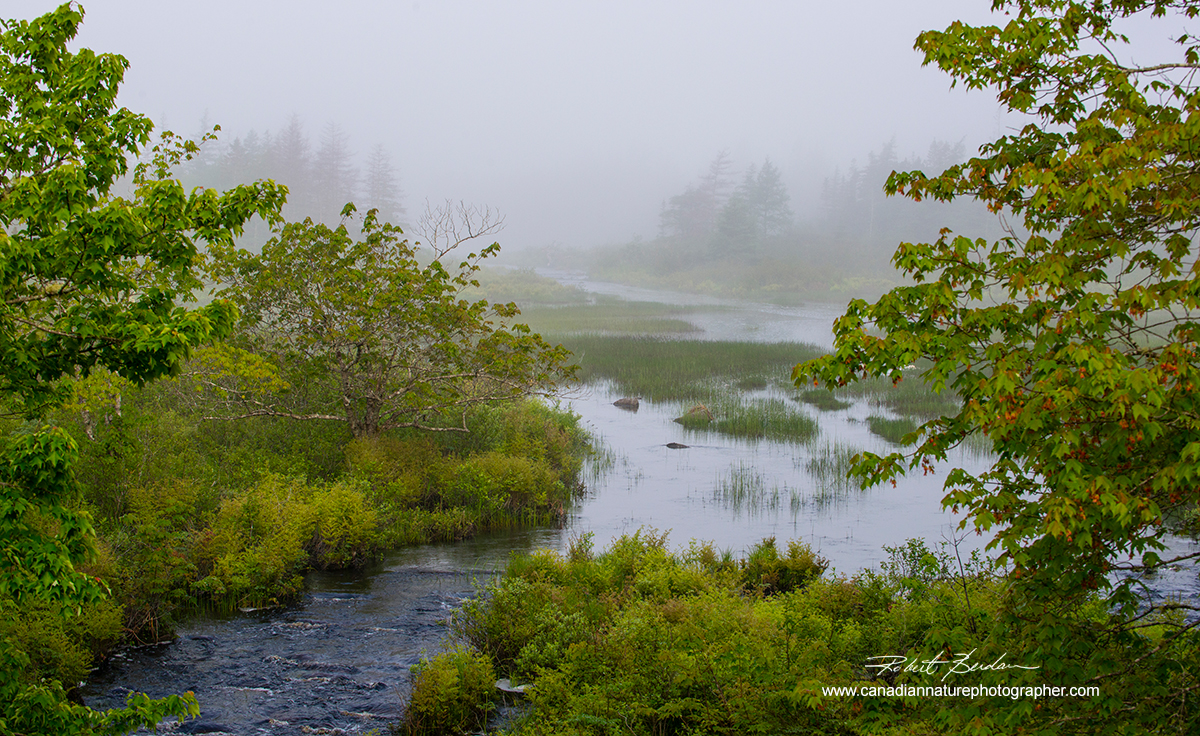
Creek flowing into a marsh, Nova Scotia.
I have always been attracted to ponds, as a kid I used to wade in them and collect insects, snails,crayfish, frogs and turtles. I am still attracted to them today. These shallow bodies of water are often calm and smooth like a mirror and reflect the vegetation around them creating beautiful shapes and abstract patterns. There is a variety of life that lives in and around ponds including reptiles, amphibians, plants, birds and insects. The photos shown in this article represent images taken over decades. I have several articles on this site showing the amazing diversity of microorganisms that live in ponds, but here I wanted to show the beauty of the ponds and some of their wildlife. Most of us can find small ponds nearby where we live and for those that have access to a microscope there is an amazing universe of alien-like microorganisms living in them.
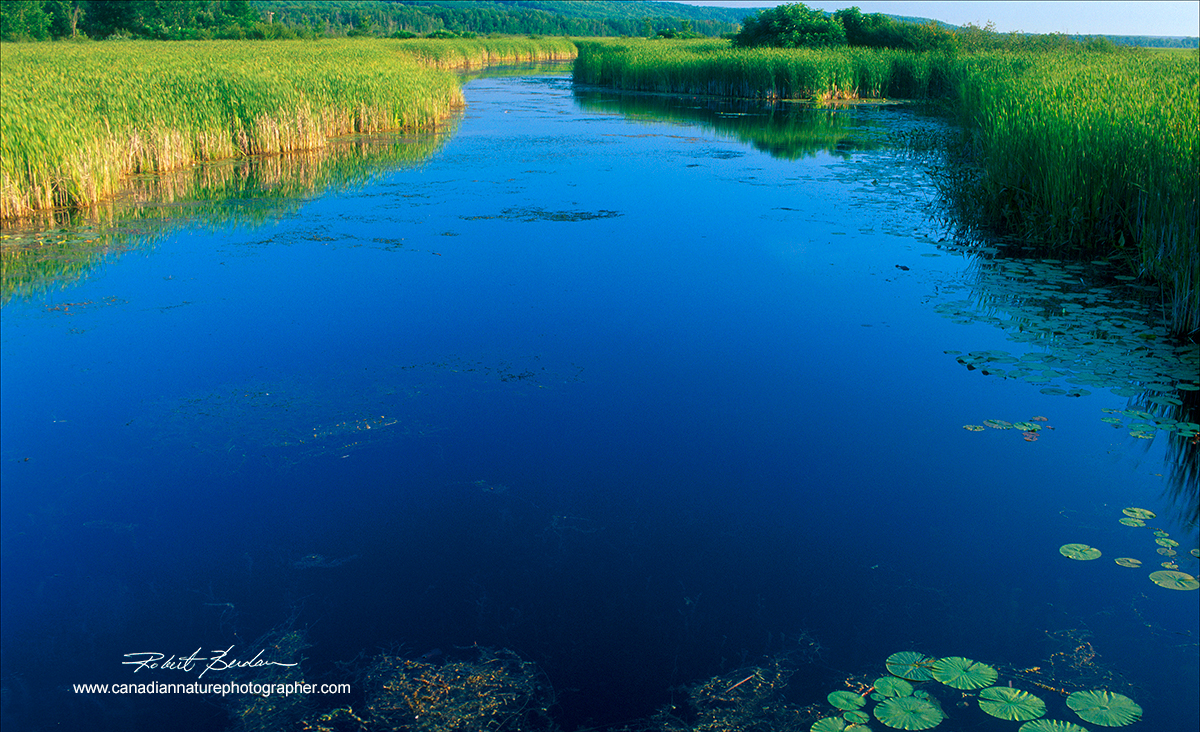
When I was growing up in Midland, Ontario I often visited the Wye Marsh shown above to collect water samples to view with my microscope and photograph wildlife. I also used to go fishing inthe Wye river for pike.
A wetland is a distinct ecosystem that is flooded by water, either permanently or seasonally, where oxygen-free processes prevail. A pond is an area filled with water, either natural or artificial, that is smaller than a lake. It may arise naturally in floodplains as part of a river system, or it can be an isolated depression. It may contain shallow water with marsh and aquatic plants and animals. Ponds are frequently man-made. Among their many uses, ponds provide water for agriculture and livestock, aid in habitat restoration, serve as fish hatcheries, may store thermal energy as solar ponds, and treat wastewater. The technical distinction between a pond and a lake has not been universally standardized (Wikipedia).
No special photographic equipment is required to photograph ponds though a telephoto lens is helpful for wildlife. A macro lens is helpful for photographing insects, plants and amphibians. A collecting net or jars will permit you to sample the organisms living in the pond. A magnifying loupe is useful to see the smaller organisms. Some ponds also support a variety of small fish and wide variety of water plants and algae. Some ponds may dry up during the summer and many of the animals have adapted to this temporary life style.
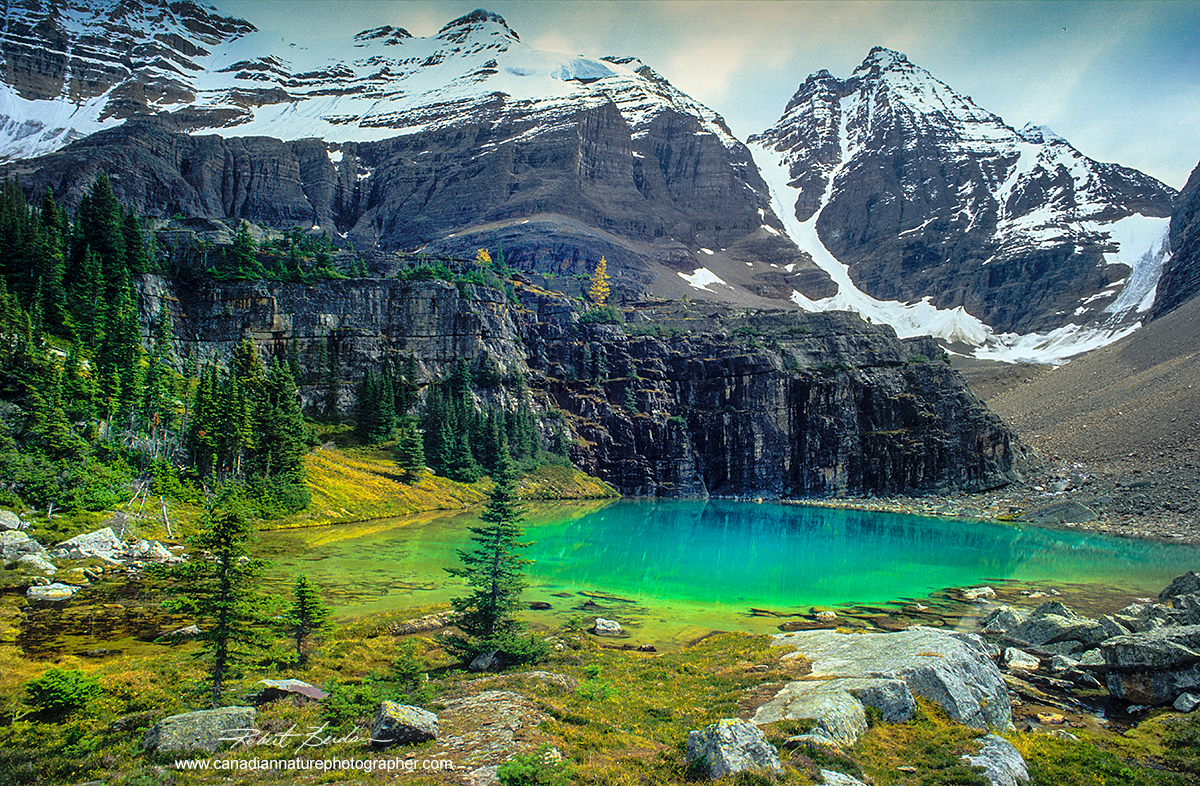
Crystal clear alpine pond in the Lake O'Hara area of British Columbia.

Mountain pond formed from melting snow near Bow Lake, Alberta.
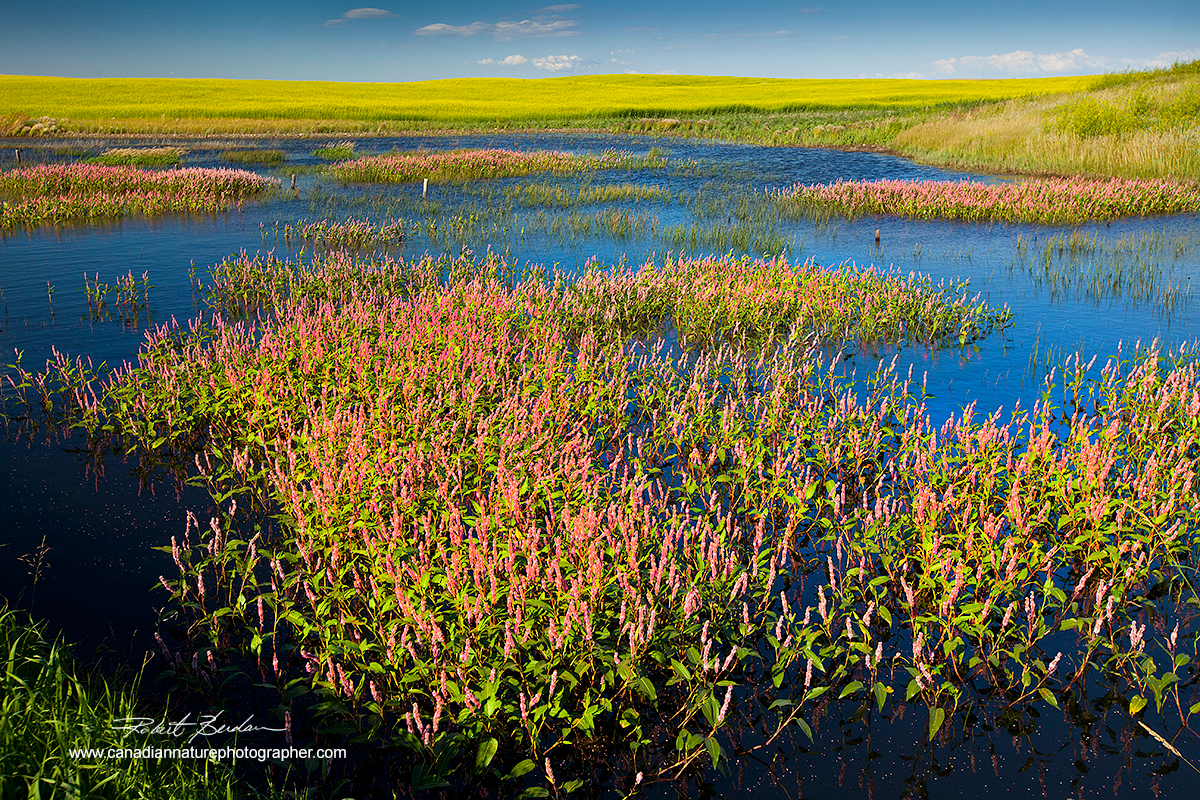
Prairie pond near Grasslands National Park, Saskatchewan (unidentified pink flowers).
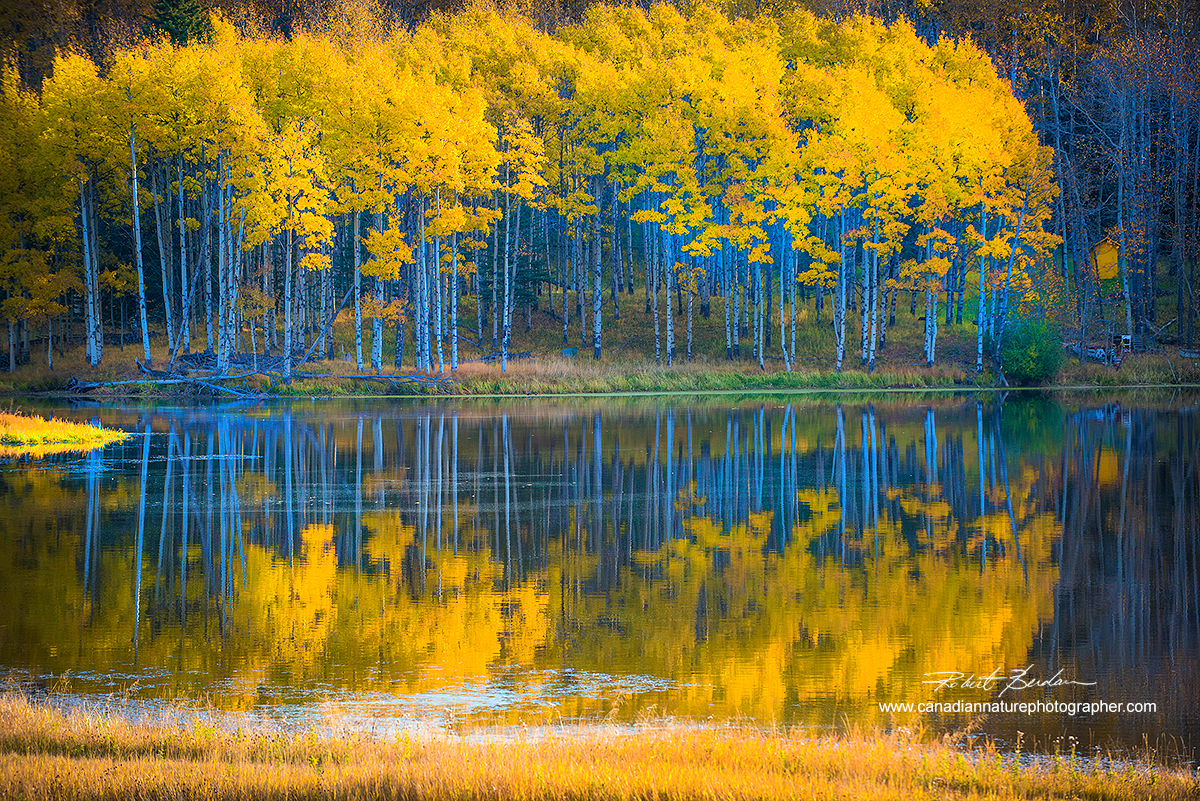
Aspens around a pond near Water Valley, Alberta in autumn.
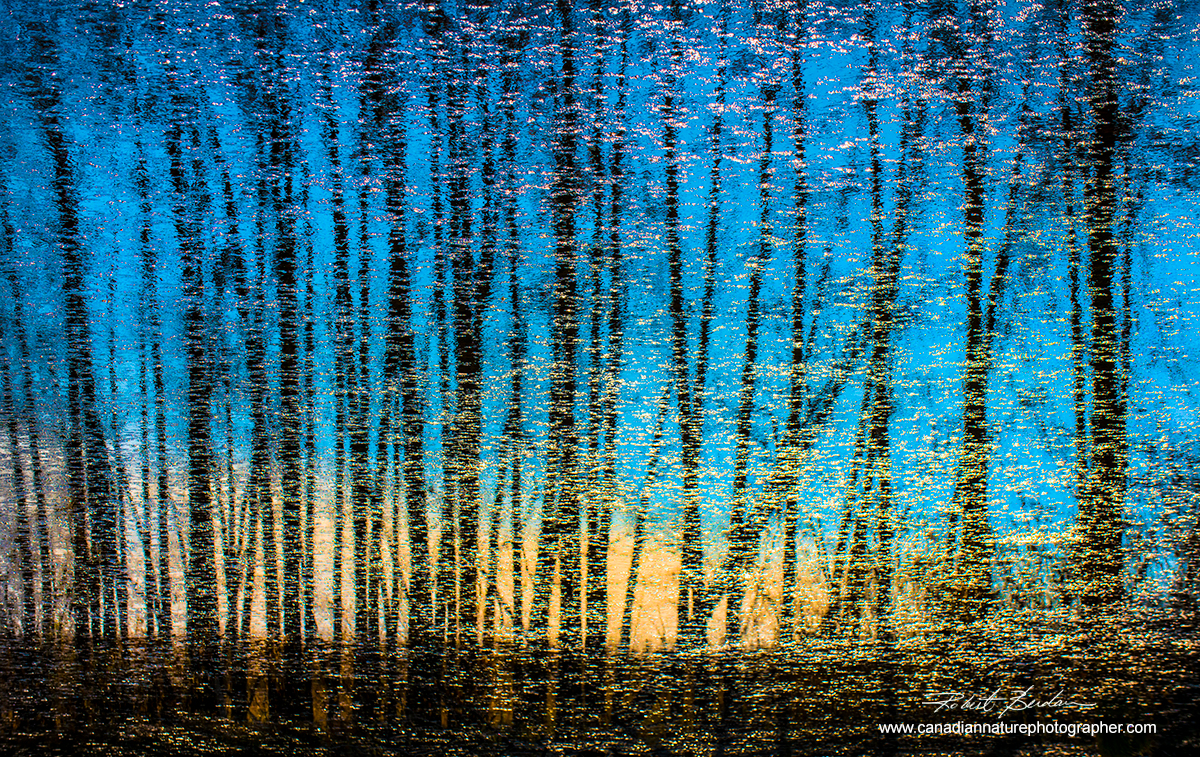
Reflections of trees in a pond form abstract artwork.
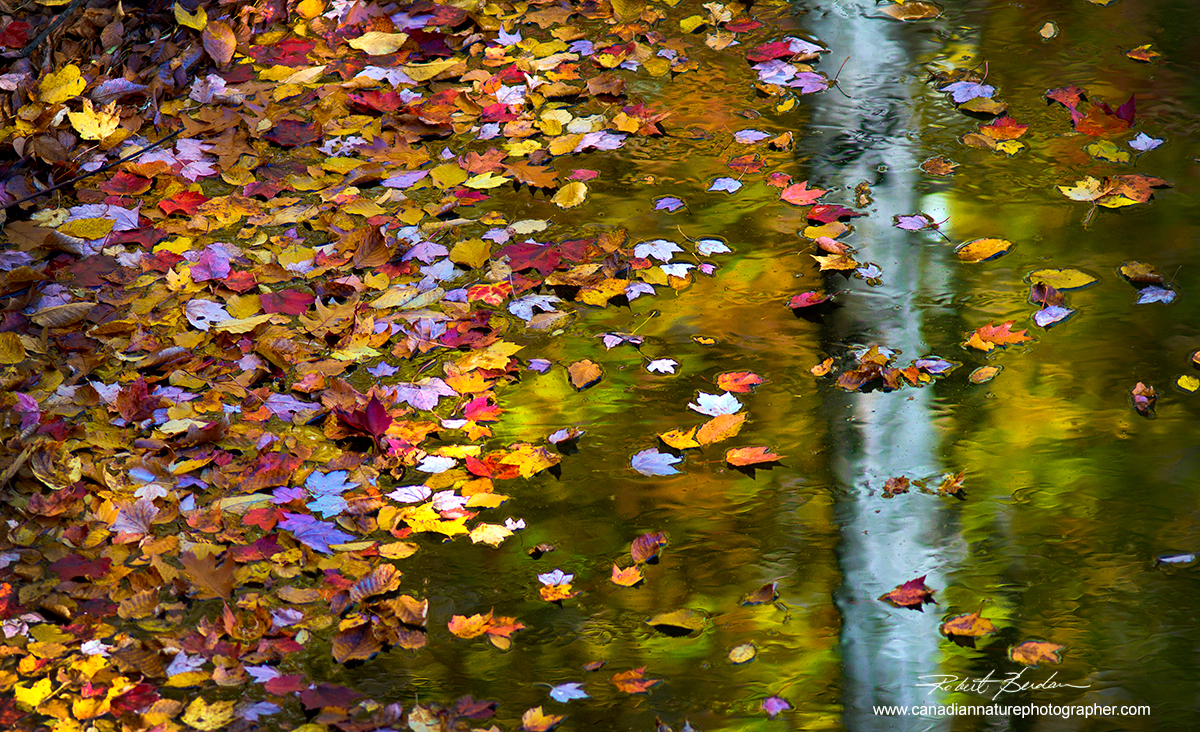
Autumn leaves in a pond, Georgian Bay, Ontario.
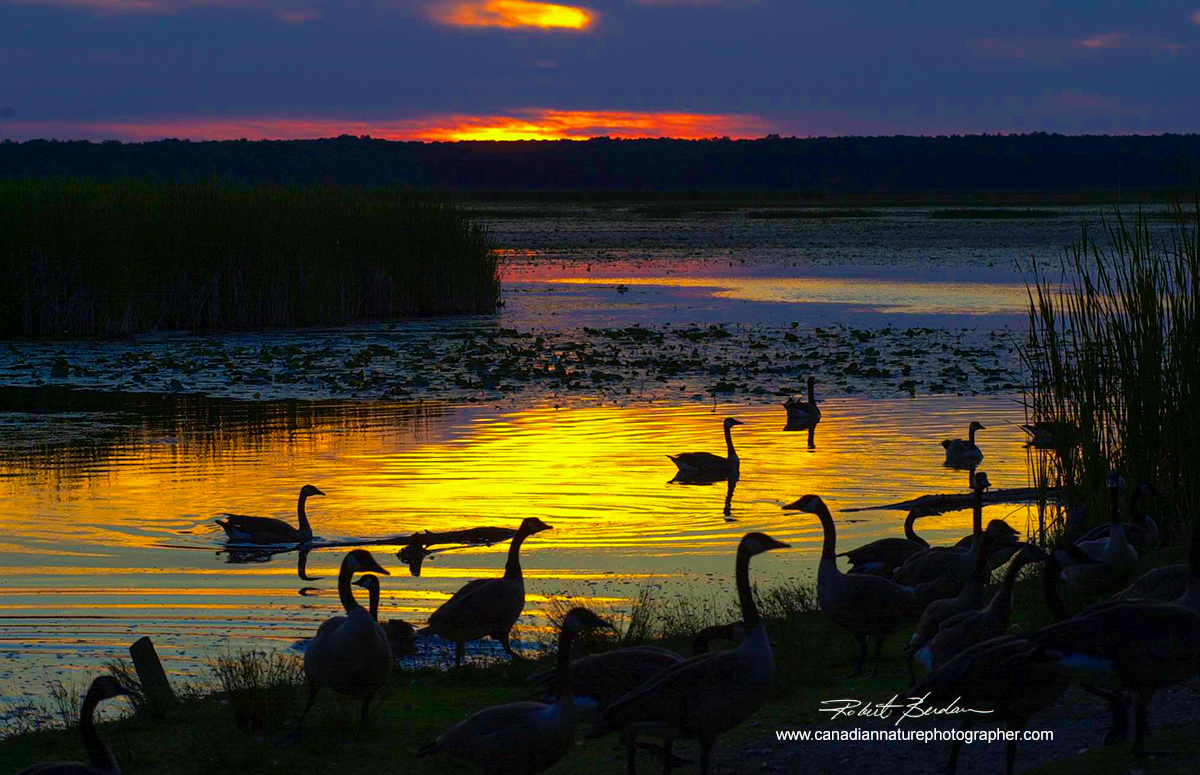
Sunset on Tiny Marsh, Ontario with Canada Geese in the foreground.
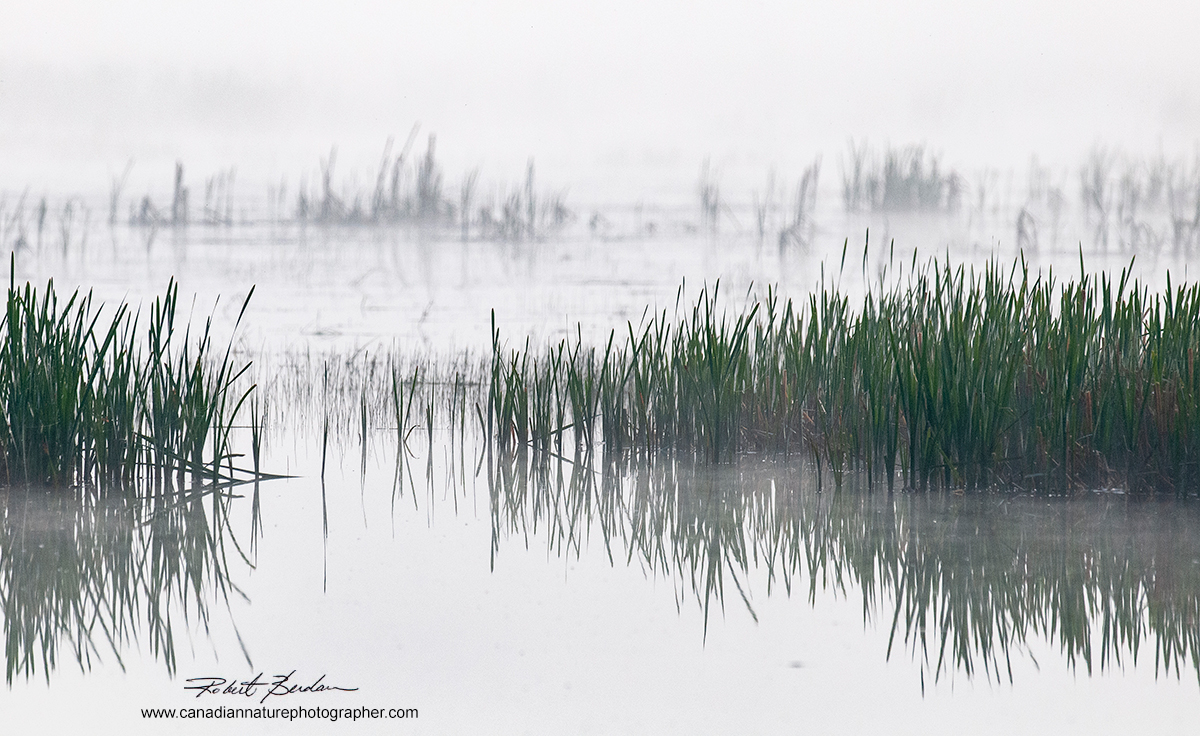
Marsh east of Calgary and north of Chestermere early morning. This marsh attracts a wide variety of shore birds. Fog covered the pond in this early morning photo.
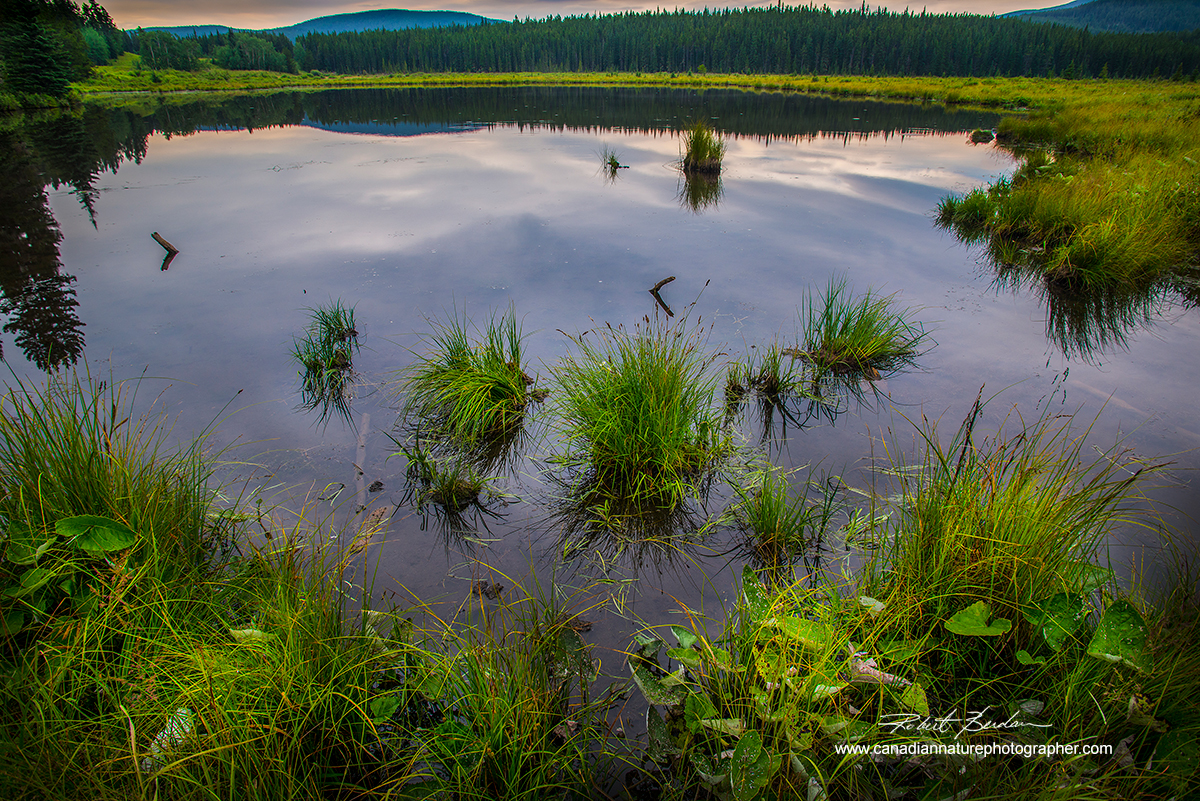
Pond near West Bragg Creek, Alberta. This pond supports a population of Wood frogs. Listen to the sound of wood frogs on this web site.
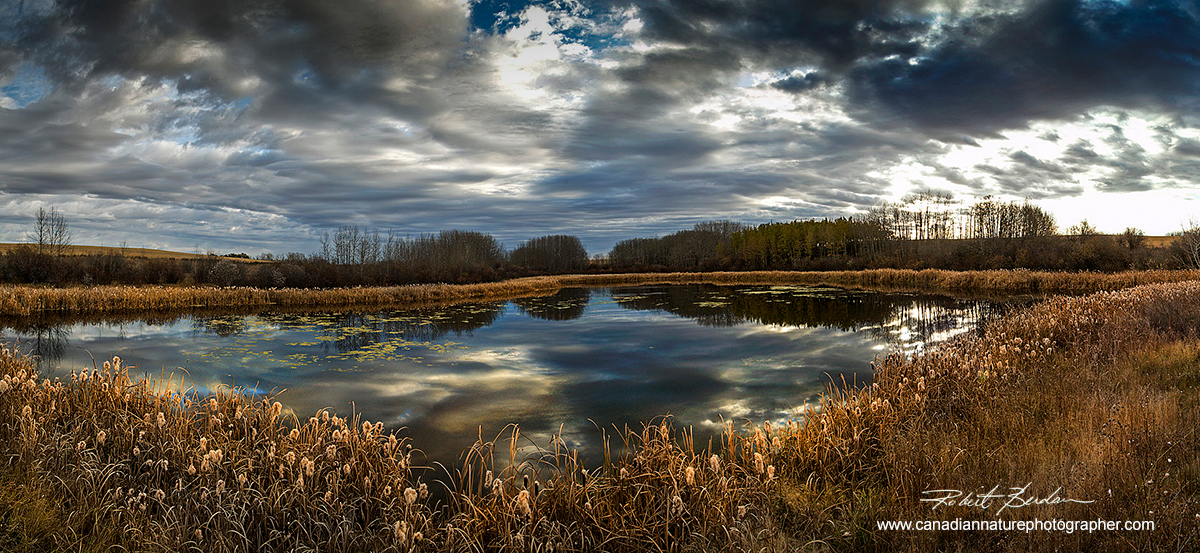
Pond in the Irricana area east of Calgary in spring (panoramic photo).
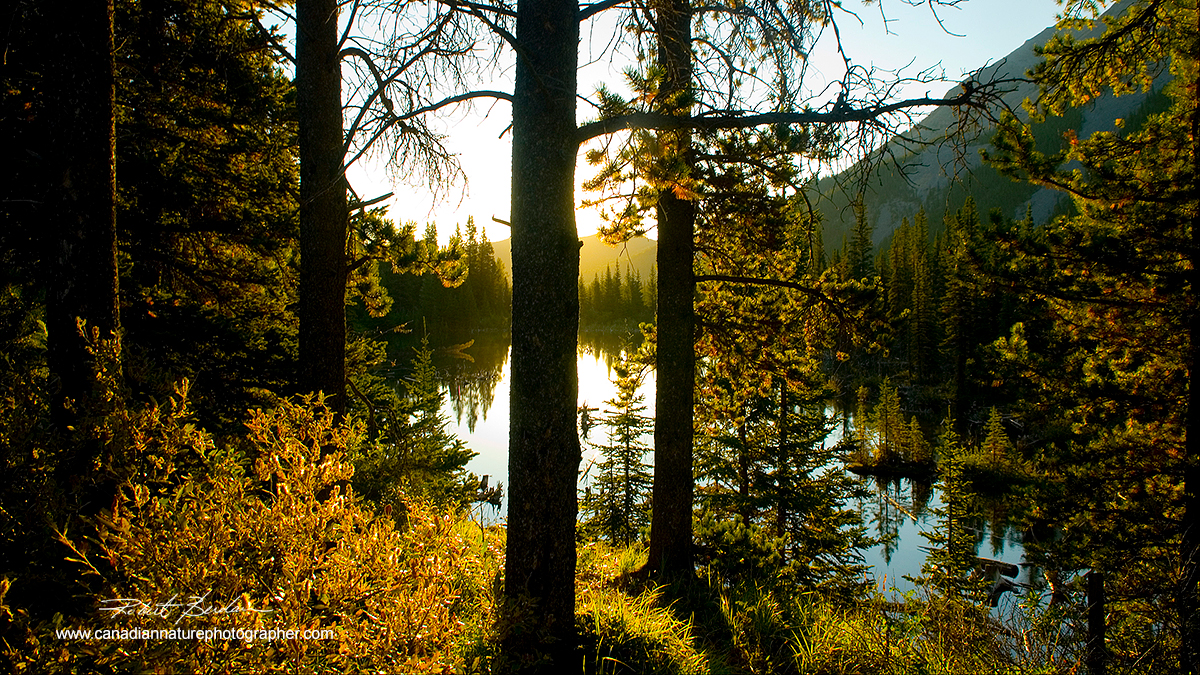
Pond in Kananaskis early morning near Bragg Creek, Alberta.
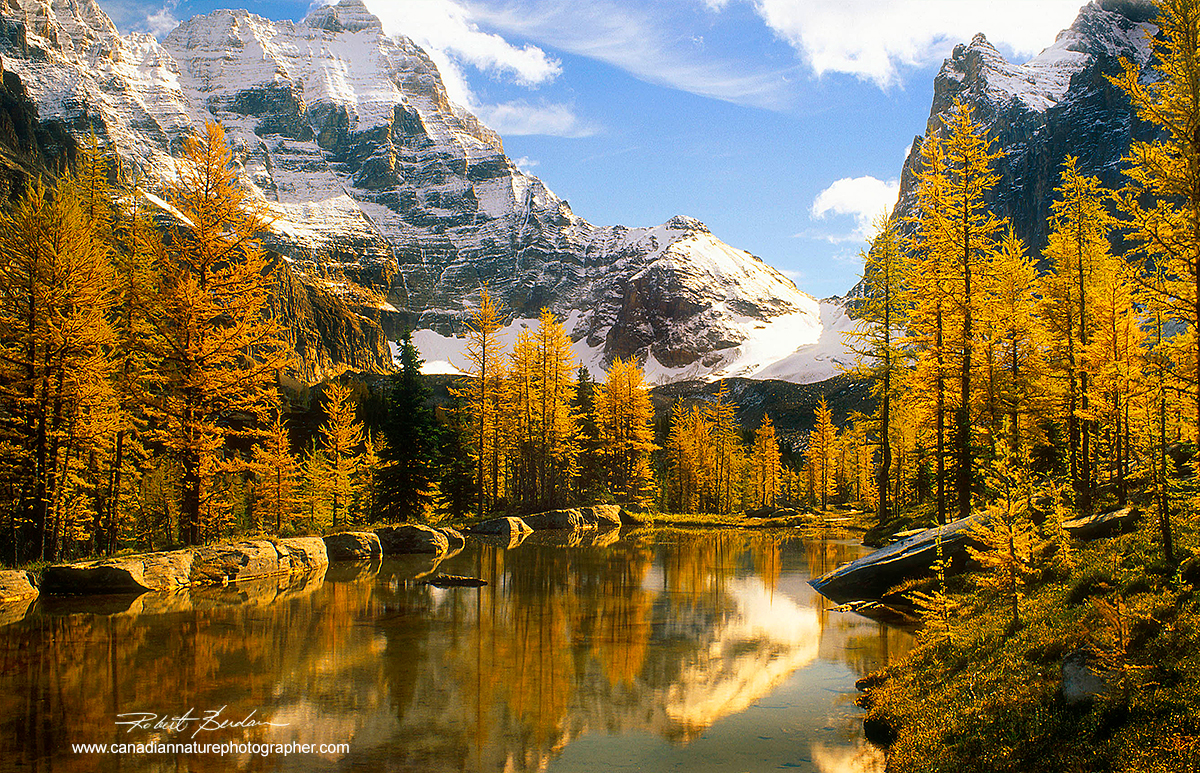
Alpine pond on the Opabin plateau Lake O'Hara surrounded by larch trees in autumn.
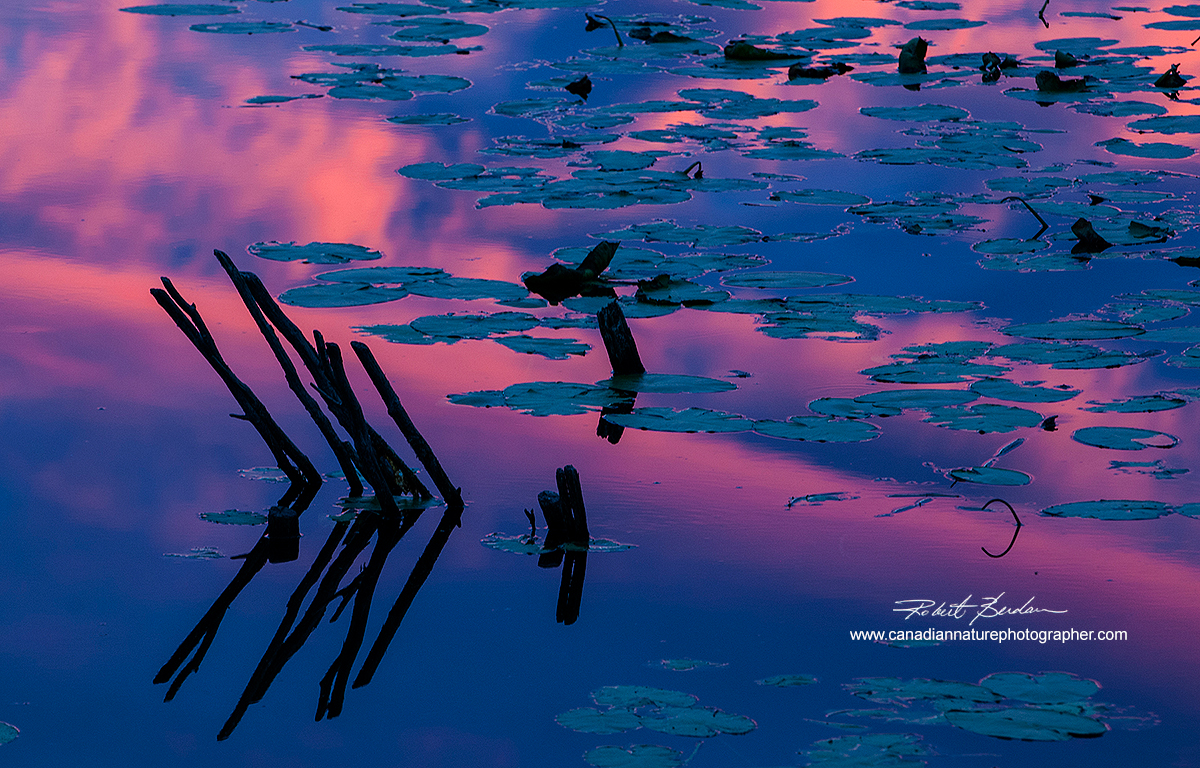
Clouds reflecting in a pond next to the Ingraham trail outside Yellowknife in early morning light.
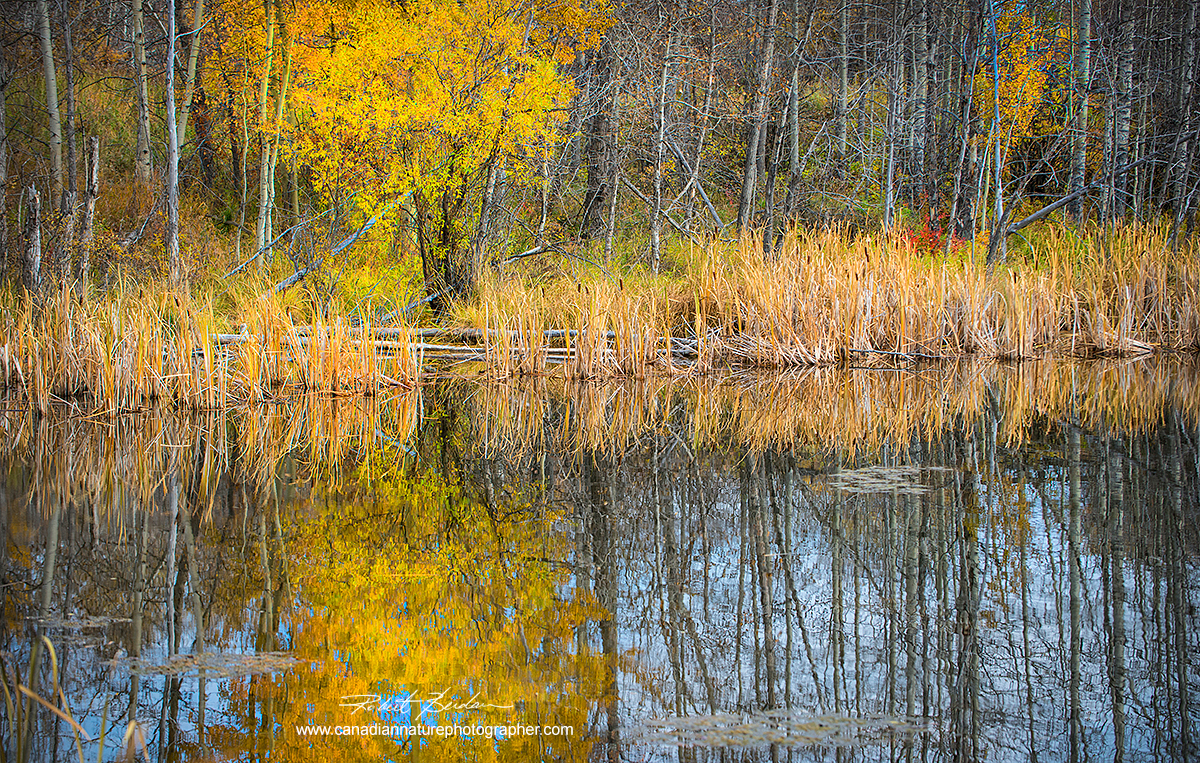
Small pond next to the road in the Bearspaw area of North West Calgary.
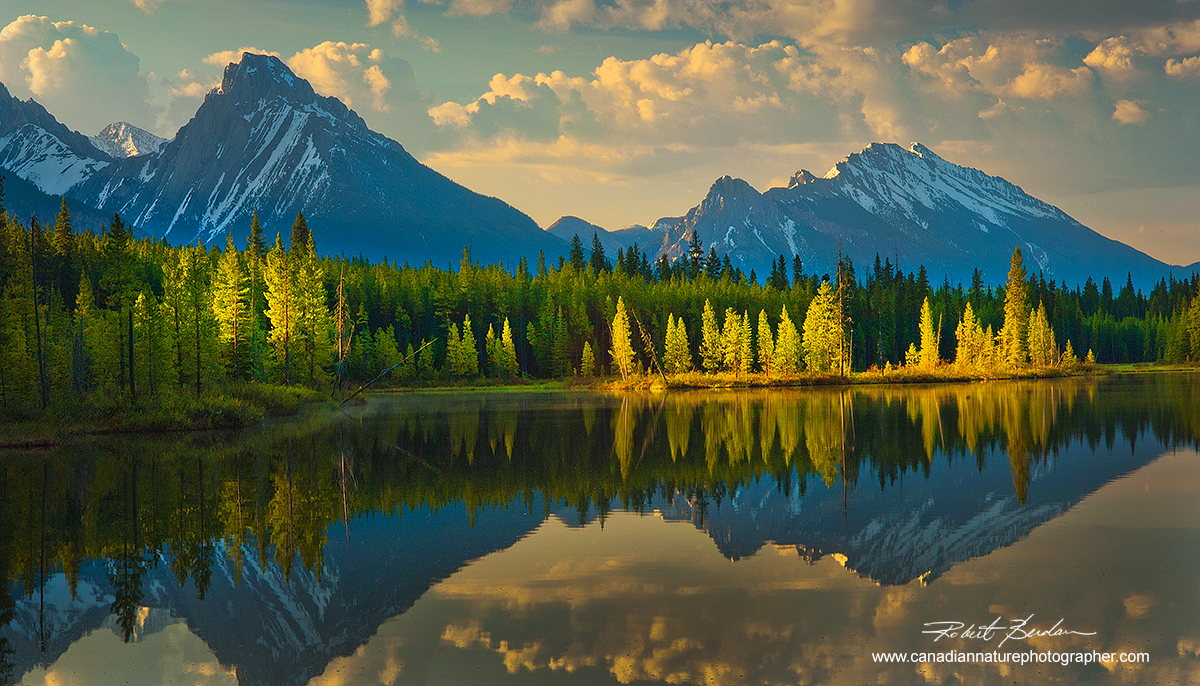
Spillway lake in Kananaskis is only a few feet deep and often calm in the mornings. This shallow lake is next to the spray lakes road and host to a variety of wildflowers in spring.
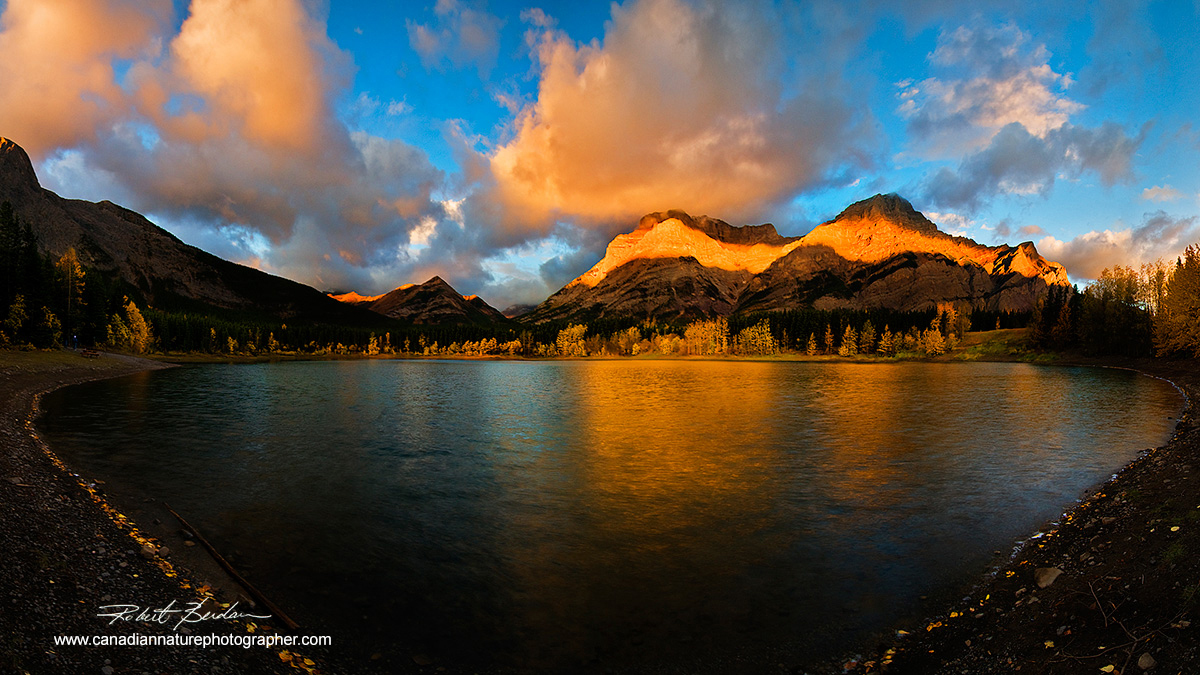
Wedge Pond in Kananaskis - Panoramic photo. This pond was created artificially and supports stocked trout. I have seen loons in the pond, moose, elk and wolves sometimes visit to drink.
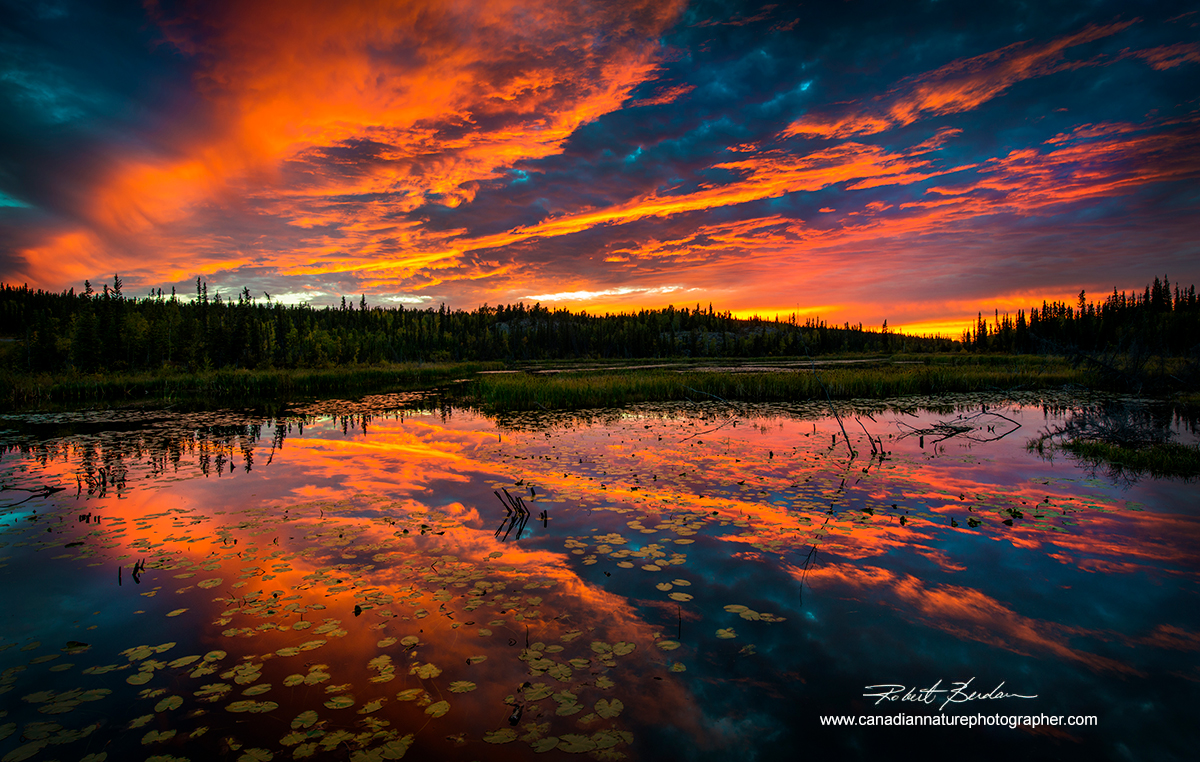
Sunset over pond next to the Ingraham Trail outside of Yellowknife, Northwest Territories. This pond hosted several beavers.
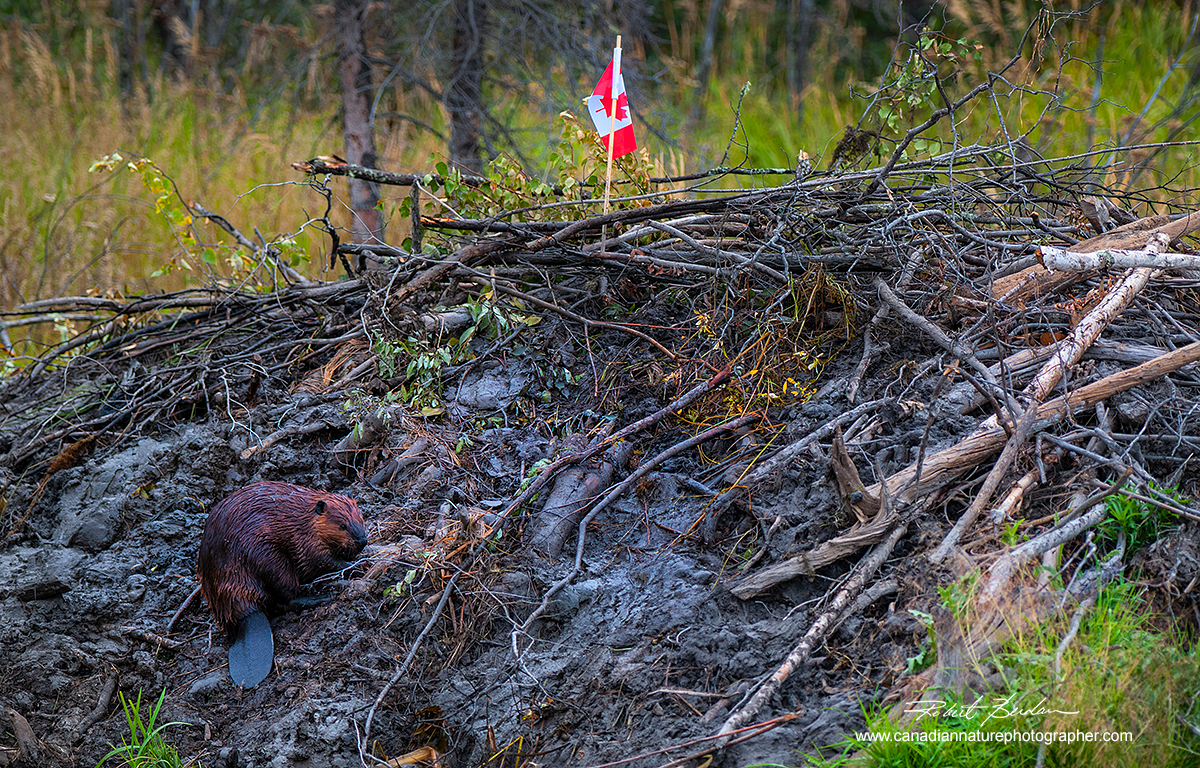
Beaver on his hut which supports a Canadian flag. I took this photograph on the same pond shown above at sunset, but this was taken early in the morning. This is one of my most "Canadian" photographs - a patriotic beaver. The flag was posted by some local Yellowknife residents. The beaver was given official status as an emblem of Canada when “An Act to provide for the recognition of the Beaver (Castor canadensis) as a symbol of the sovereignty of Canada” and received royal assent on March 24, 1975.
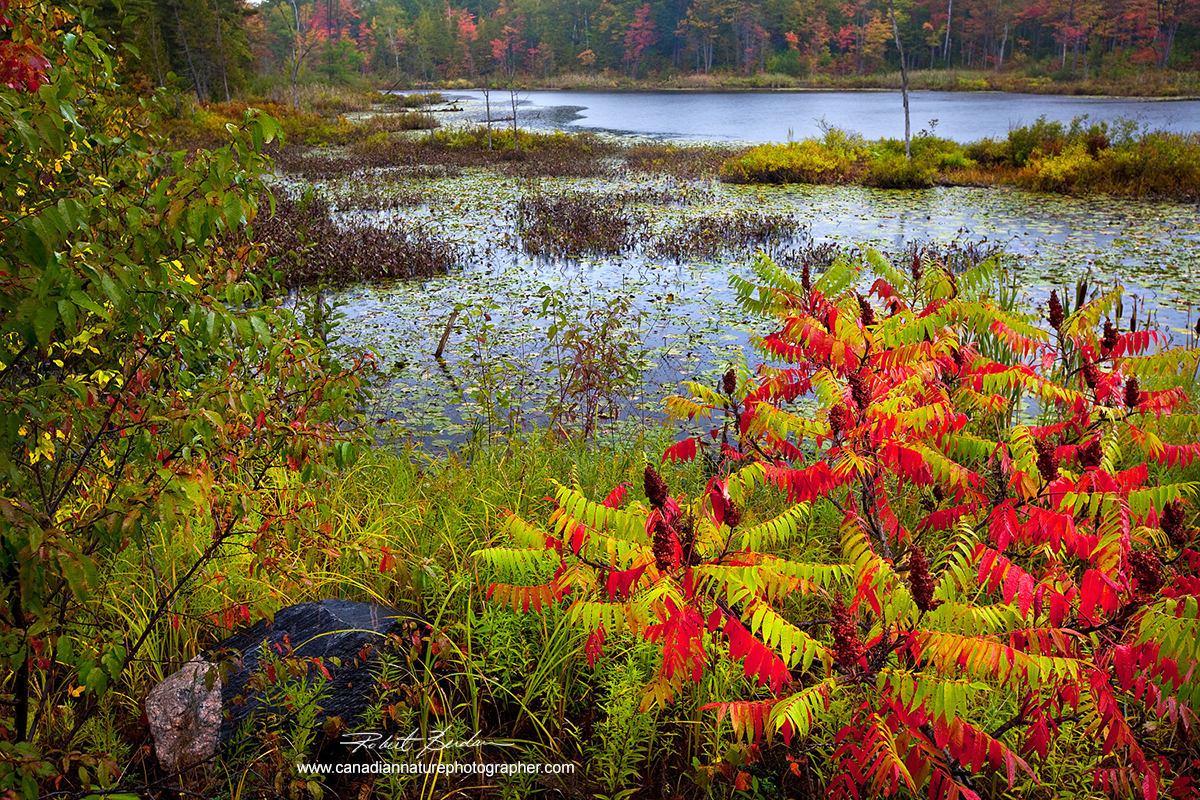
Marsh near Port Severn Ontario in autumn. In the lower left are colourful Sumac trees. Sumac fruits are also used to make a traditional "pink lemonade" beverage by steeping in water before straining to remove hairs which may irritate the mouth or throat, sometimes adding sweeteners such as honey or sugar.
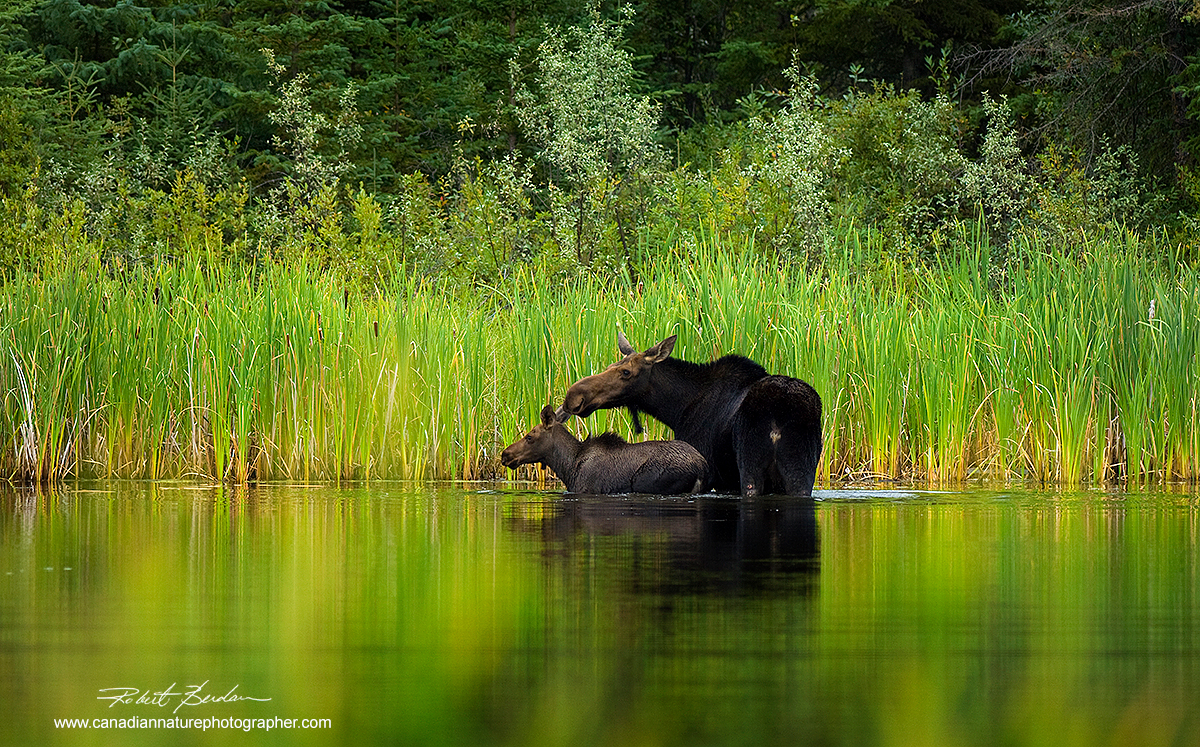
Moose and calf in shallow pond next to highway near High Level, Alberta.
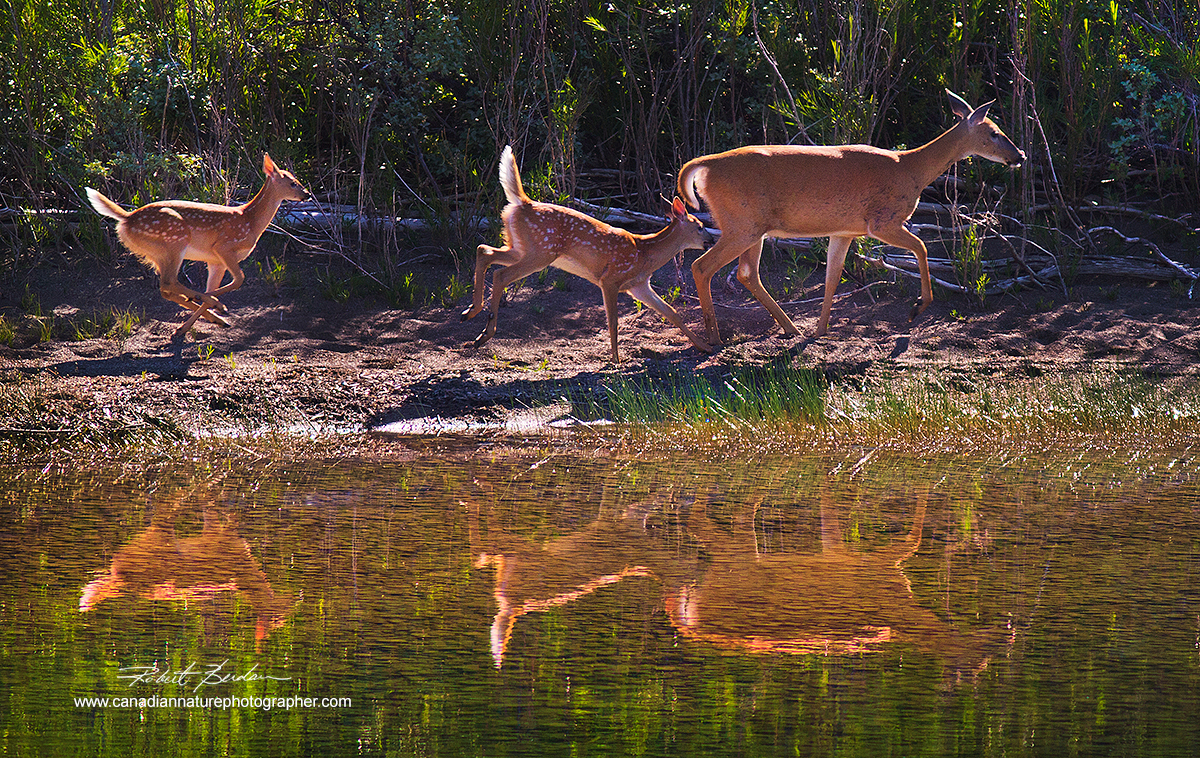
White-tailed deer and two Does next to a shallow pond in Waterton National Park, Alberta.
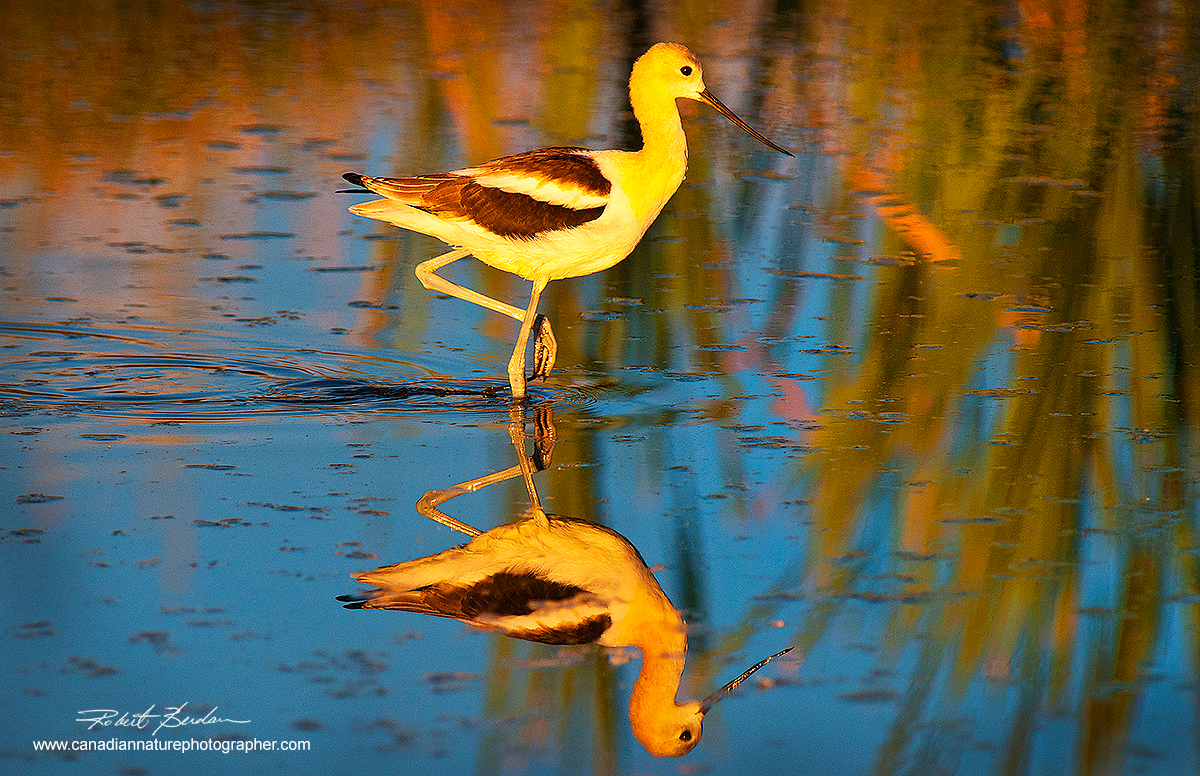
American avocet photographed at Weed lake east of Calgary, Alberta. Avocets are beautiful shore birds that will feed on crayfish, small fish and insects.
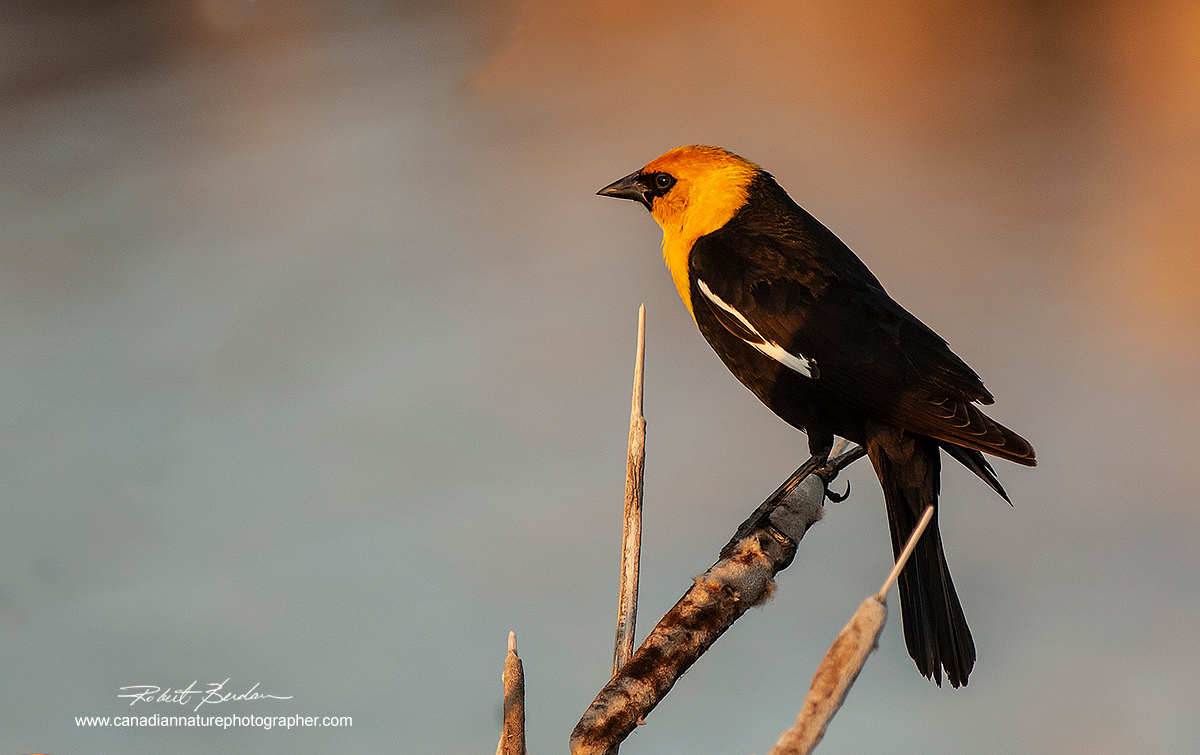
Yellow-headed black bird (male) on cattail in a marsh east of Calgary. These birds make a nasal whaa sound and a song composed of a series of harsh crackling noises and a long wailing trill.
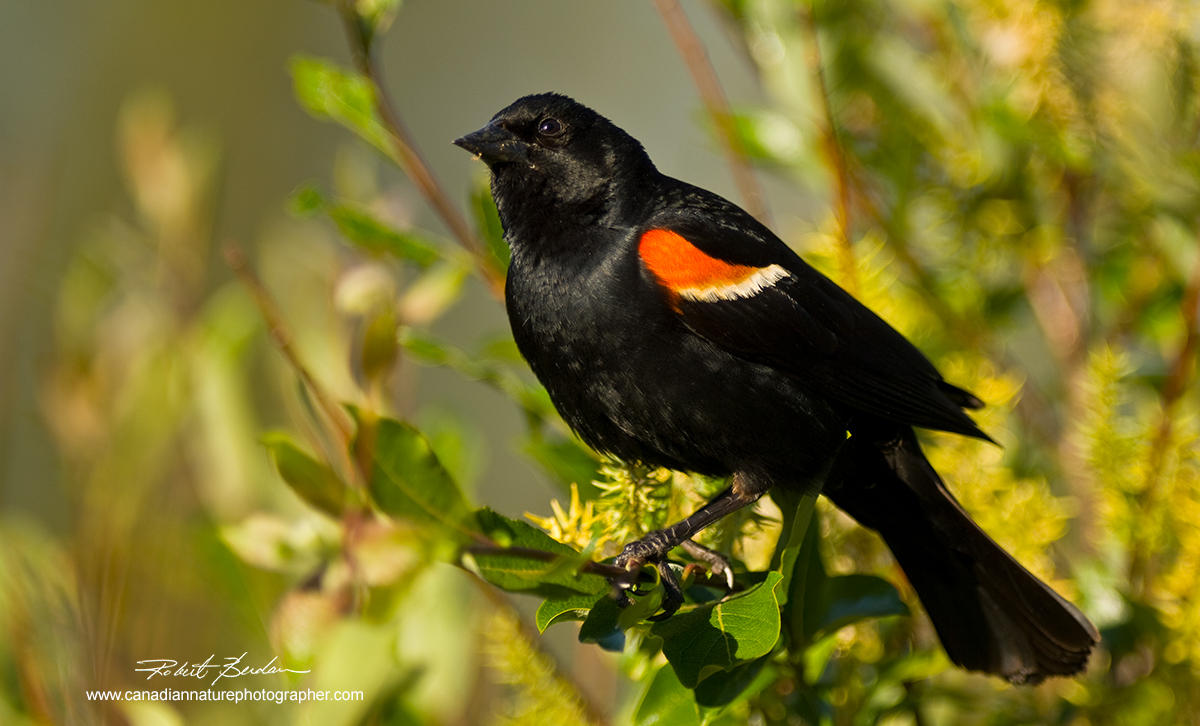
Red-winged black birds are common around ponds and marshes. The red-winged blackbird is sexually dimorphic; the male is all black with a red shoulder and yellow wing bar, while the female is mottled brown in colour (shown below). Listen to the distinct sound of a red-winged blackbird.
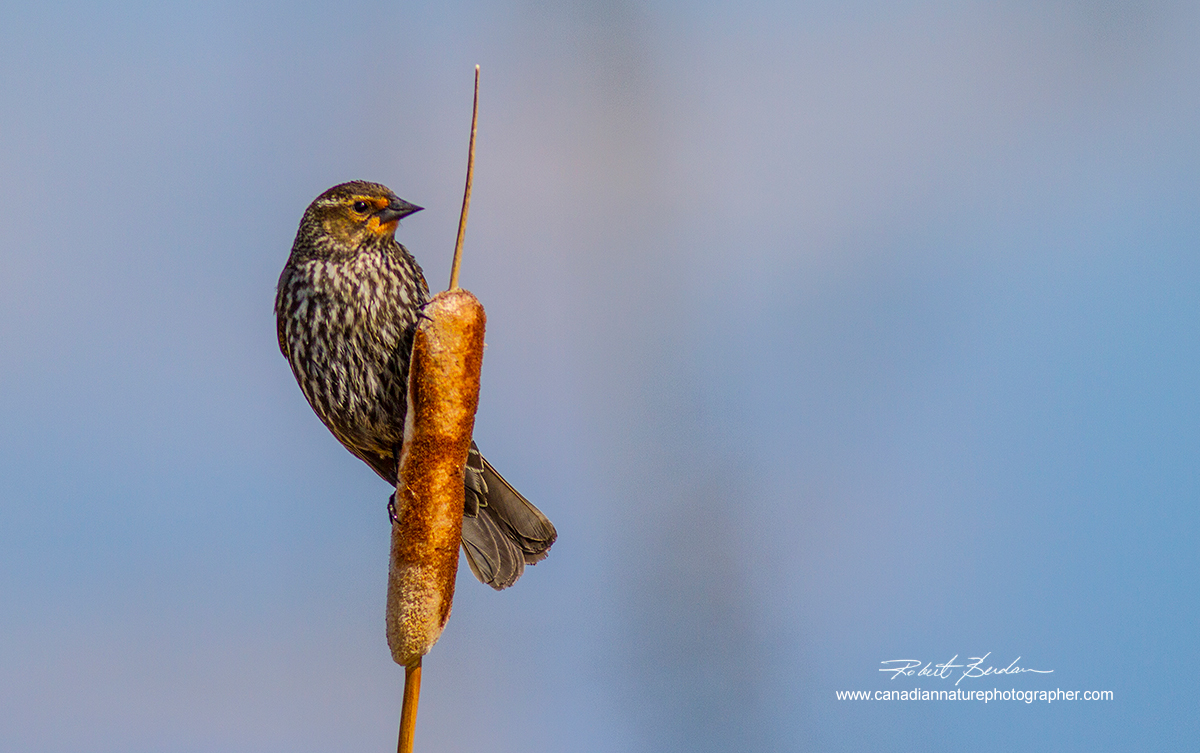
Above is a female red-winged blackbird. Seeds and insects make up the bulk of the red-winged blackbird's diet. The female is blackish-brown and paler below.
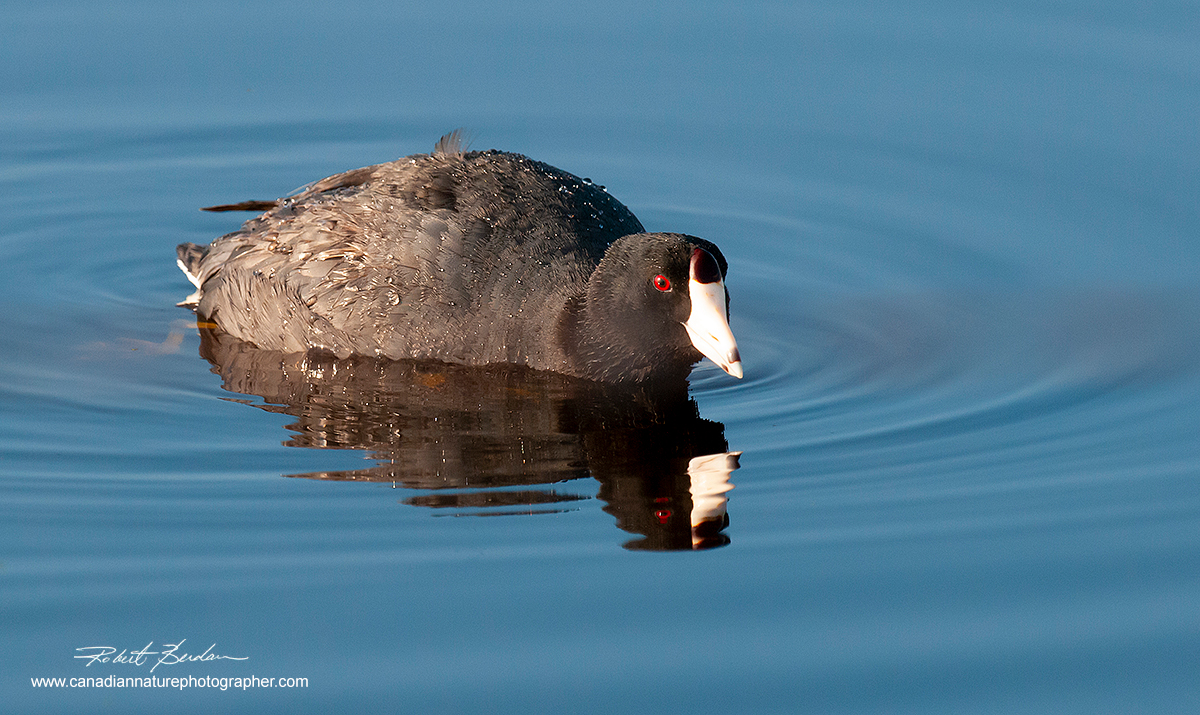
American Coot photographed in a small pond in Bearspaw North West Calgary. They have big feet and their babies are truly "ugly ducklings".
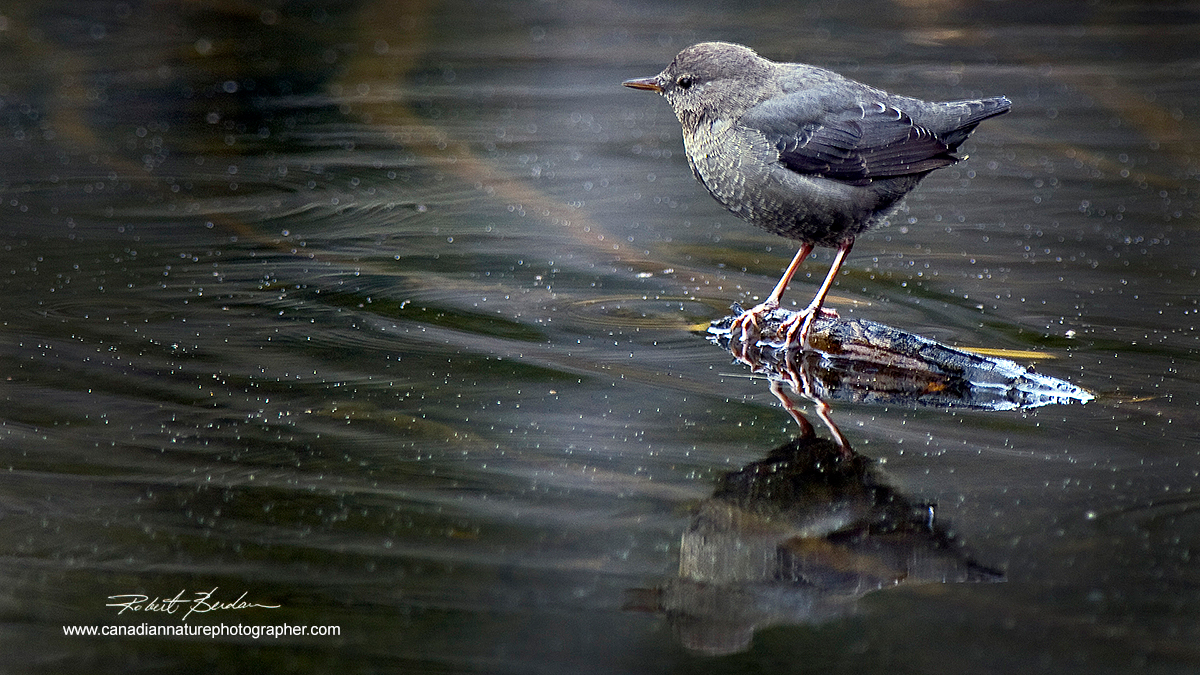
American Dipper photographed in a small pond next along the Spray Lakes road, Kananaskis, AB. These birds swim under water to catch insects and small fish and are also common around fast moving mountain streams.
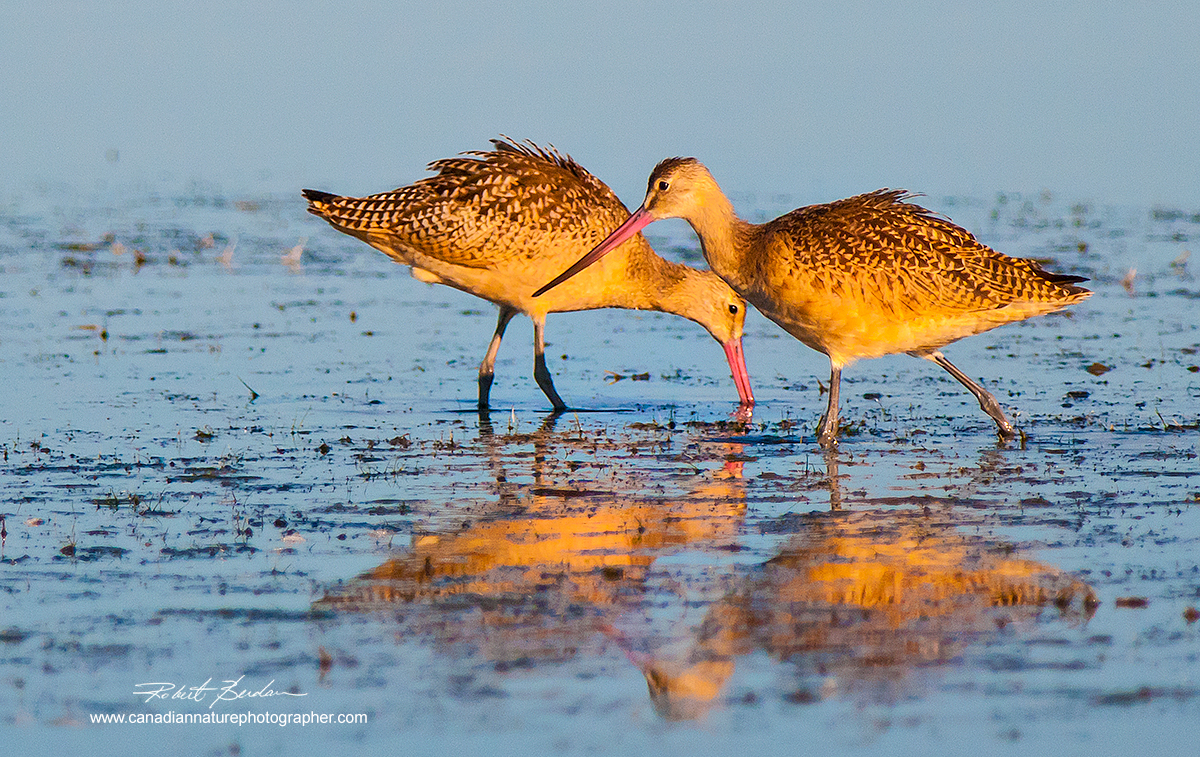
Marbled Godwits wading in shallow water near Frank Lake, Alberta. This bird likes to feed on mudflats and flooded plains. These birds can live up to 29 years in the wild.
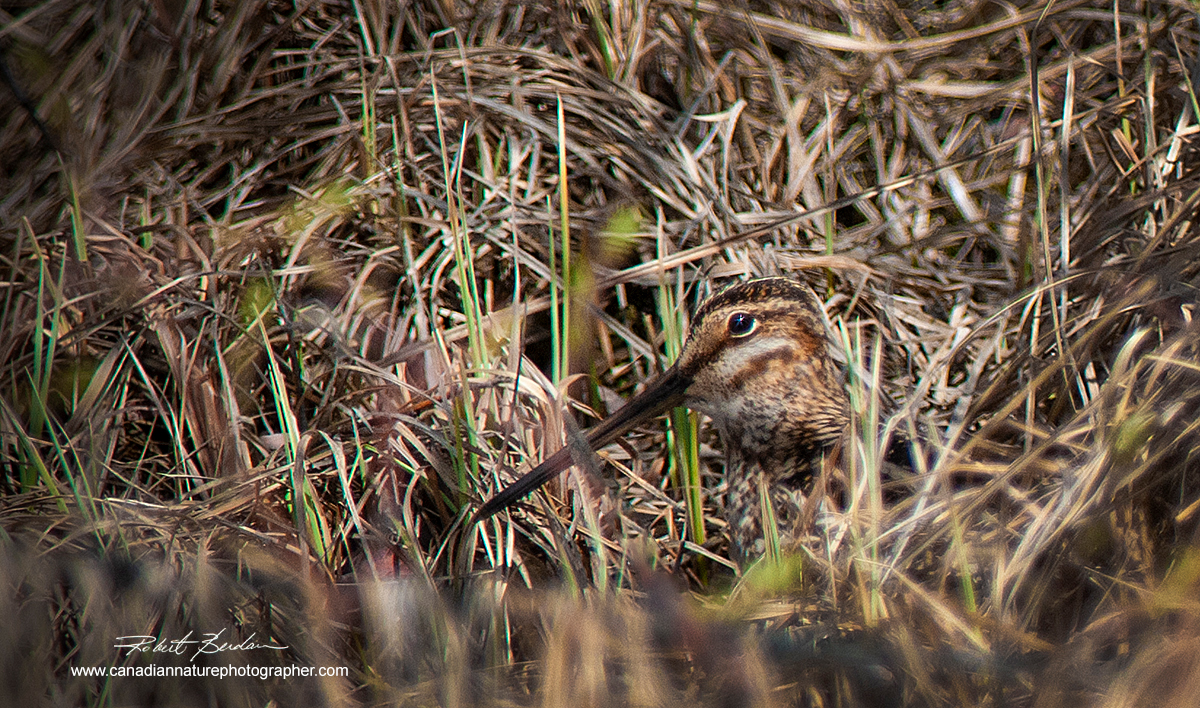
Common snipe hiding in the grass next to a small pond near Bragg Creek Alberta.
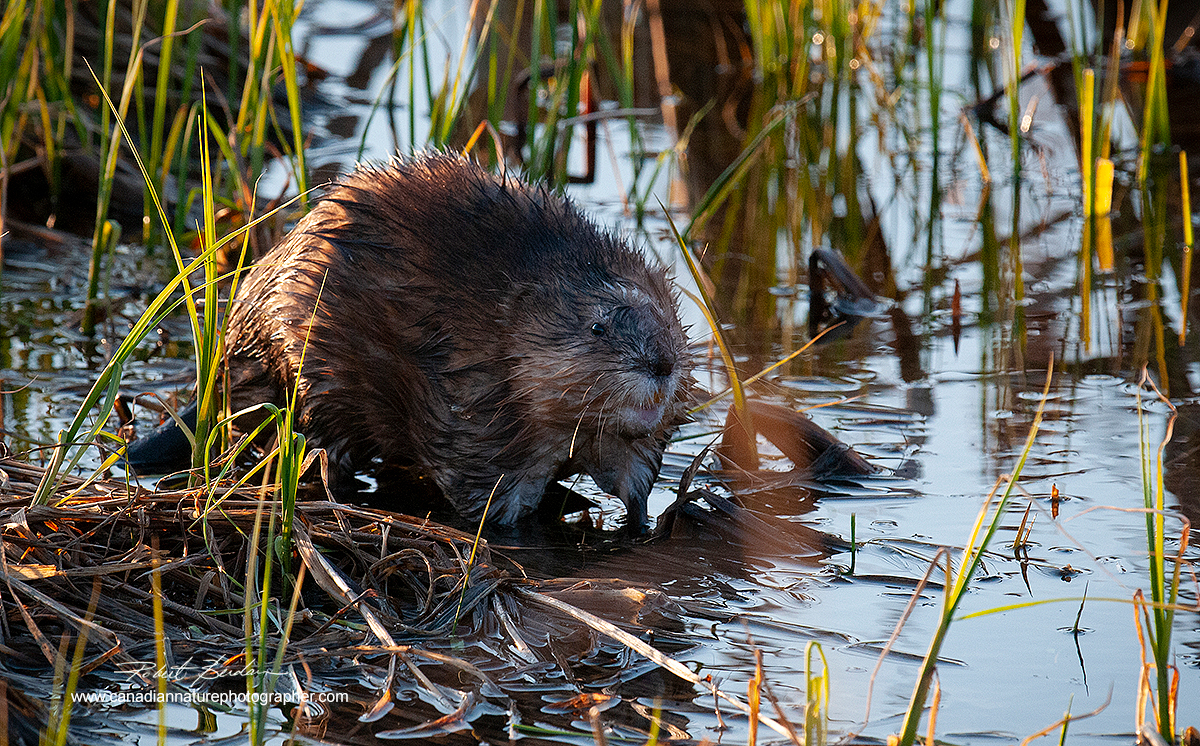
Muskrat in pond north of Calgary along highway 1A to Cochrane.
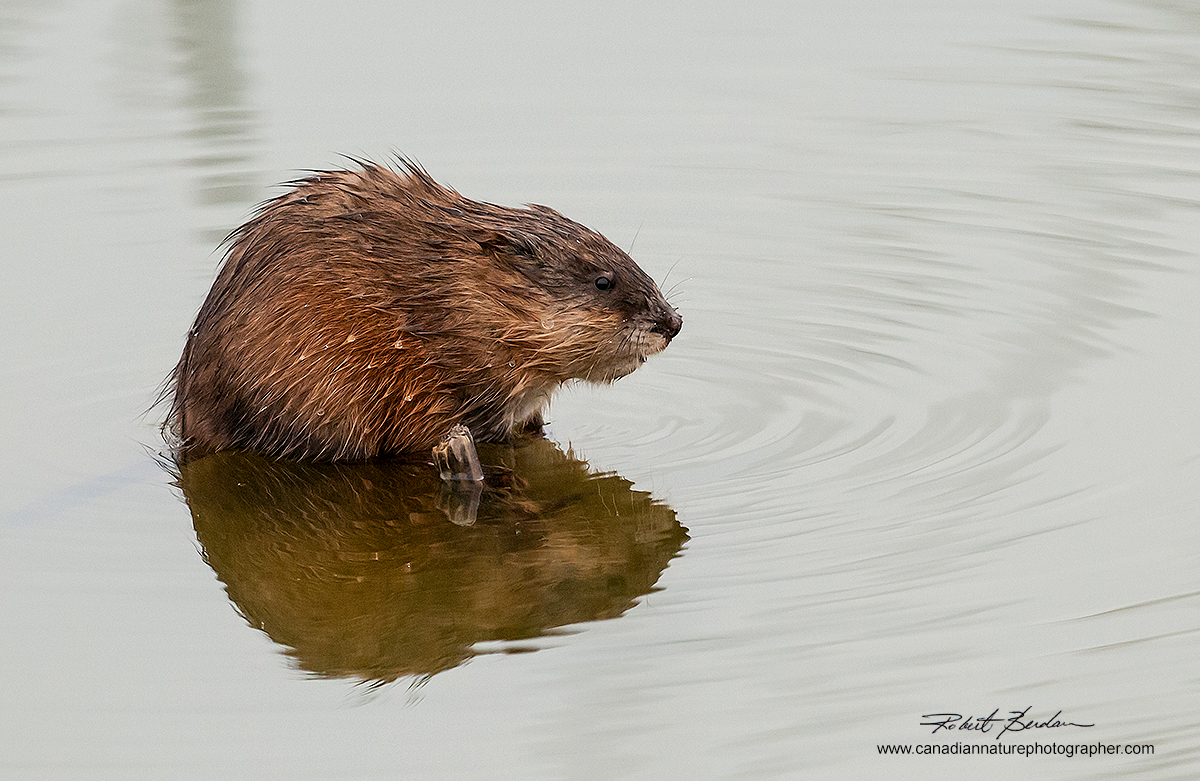
Muskrat in a pond in Bearspaw north of Calgary, AB. Muskrats form small pyramid shaped huts made of grass.
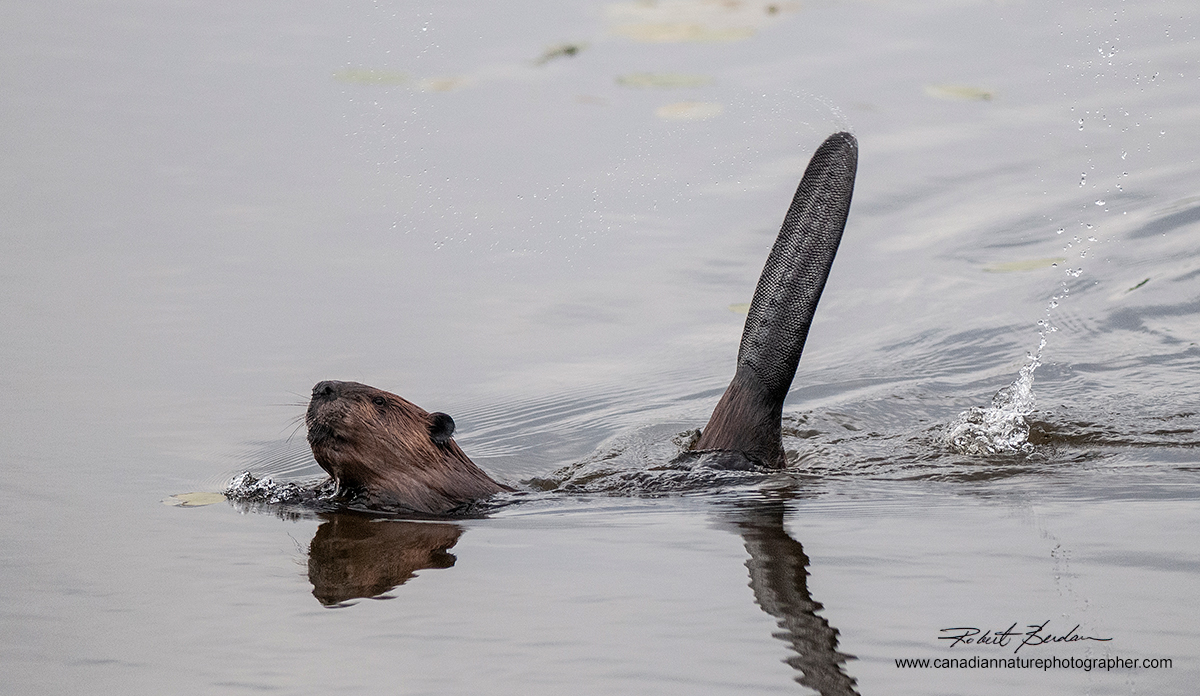
Beaver slapping its tail on the water as a warning of danger.
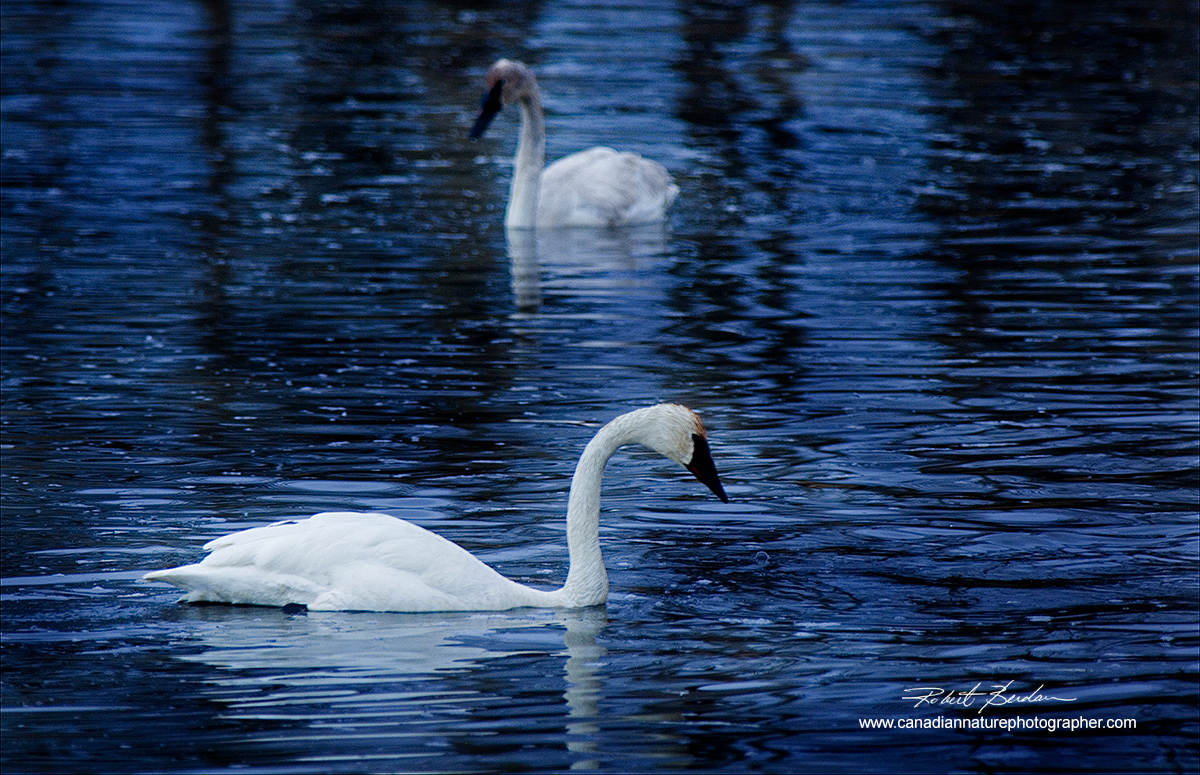
Trumpeter swans photographed in ponds next to highway 1 enroute to Banff, Alberta. It is the heaviest living bird native to North America, it is also the largest extant species of waterfowl with a wingspan that may exceed 10 ft (3.0 m).
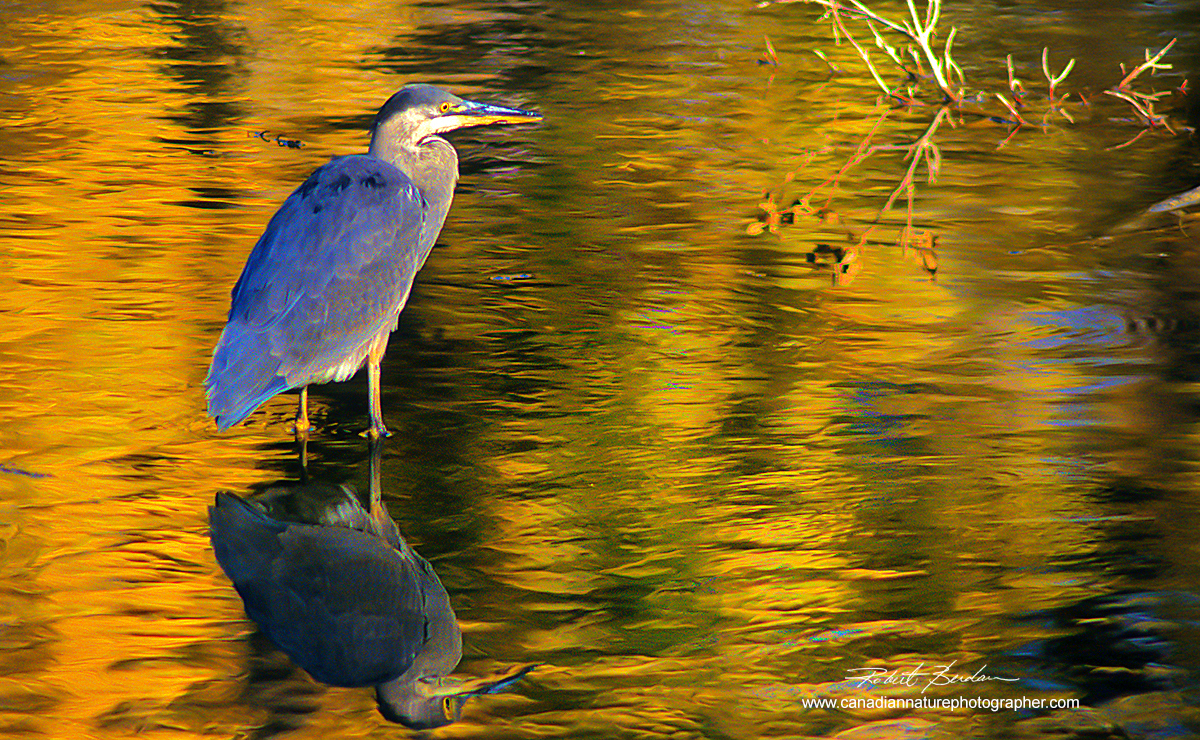
Great blue heron Inglewood bird sanctuary in Calgary. These birds are common near the shores of open water and in wetlands over most of North America. It is the largest North American heron.
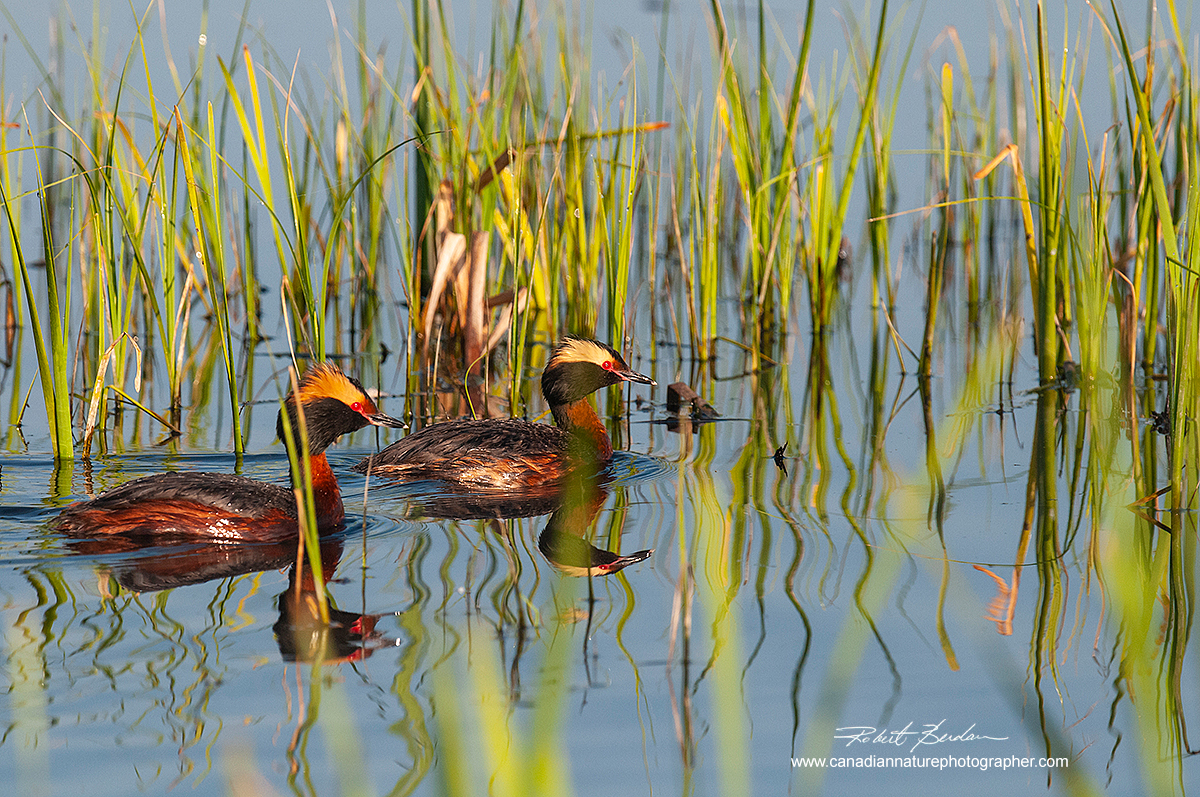
Pair of adult horned grebes, next to Ingraham Trail, Northwest Territories. The species got its name from large patches of yellowish feathers located behind the eyes, called "horns", that the birds can raise and lower at will.
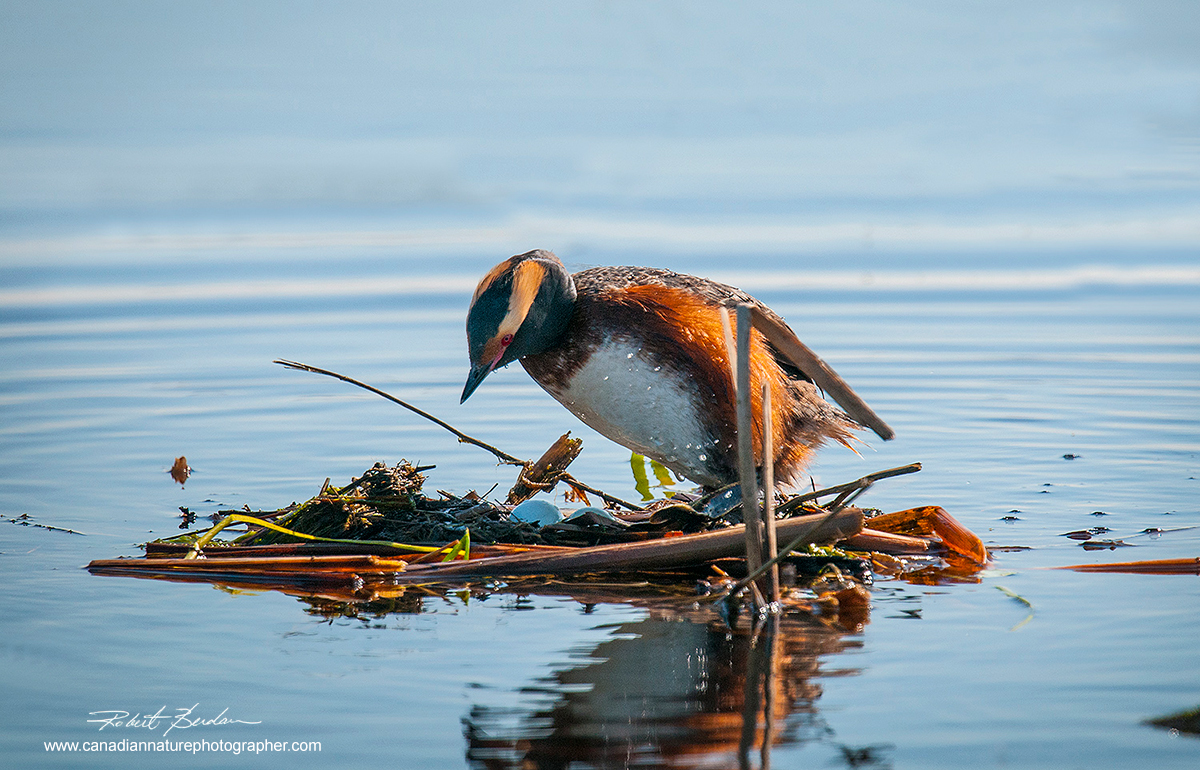
Horned grebe on a floating nest east of Calgary near Weed Lake.
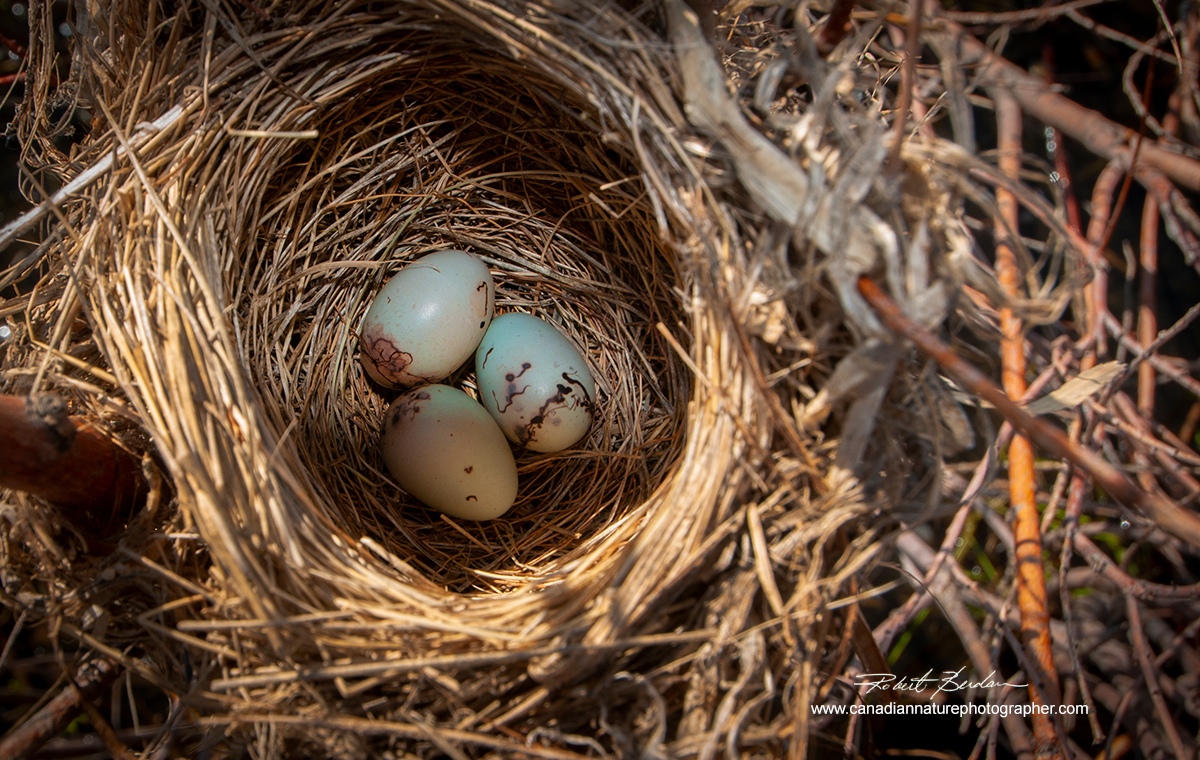
Eggs in a nest found around the edge of marsh east of Calgary, Alberta.
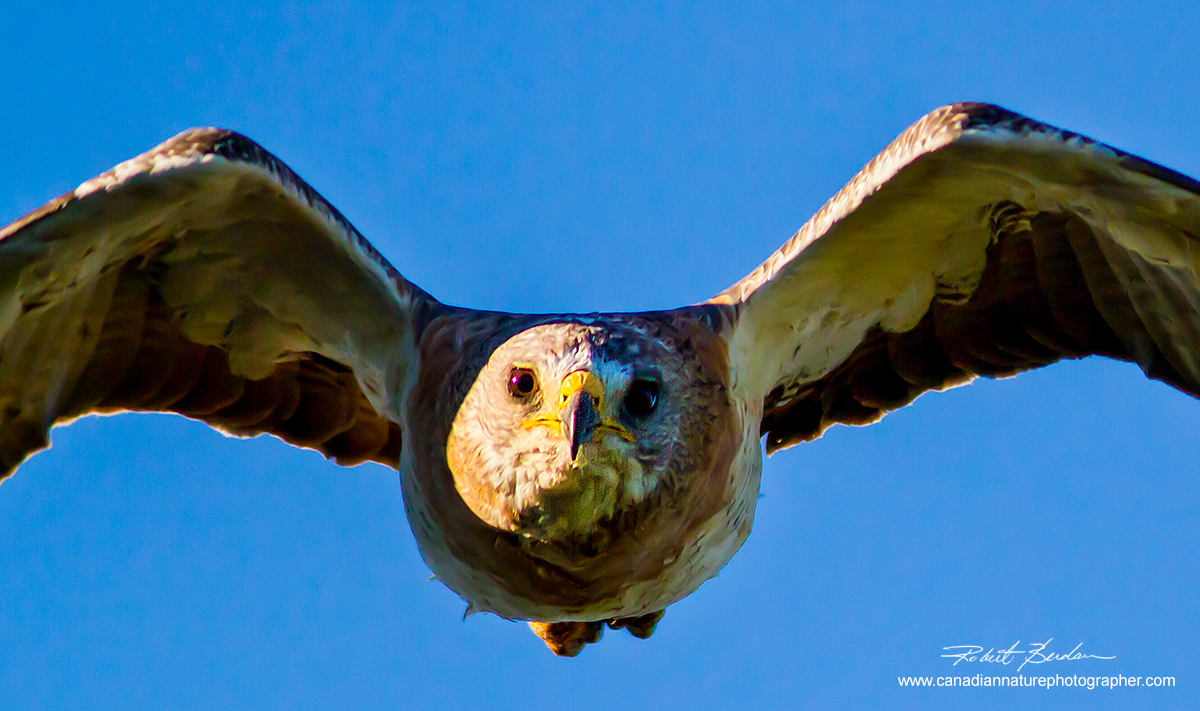
Red-tailed hawk flying toward me at Weed Lake east of Calgary. It is one of the most common members within the genus of Buteo in North America or worldwide. You may hear the call of Red-tailed hawk in some western movies.
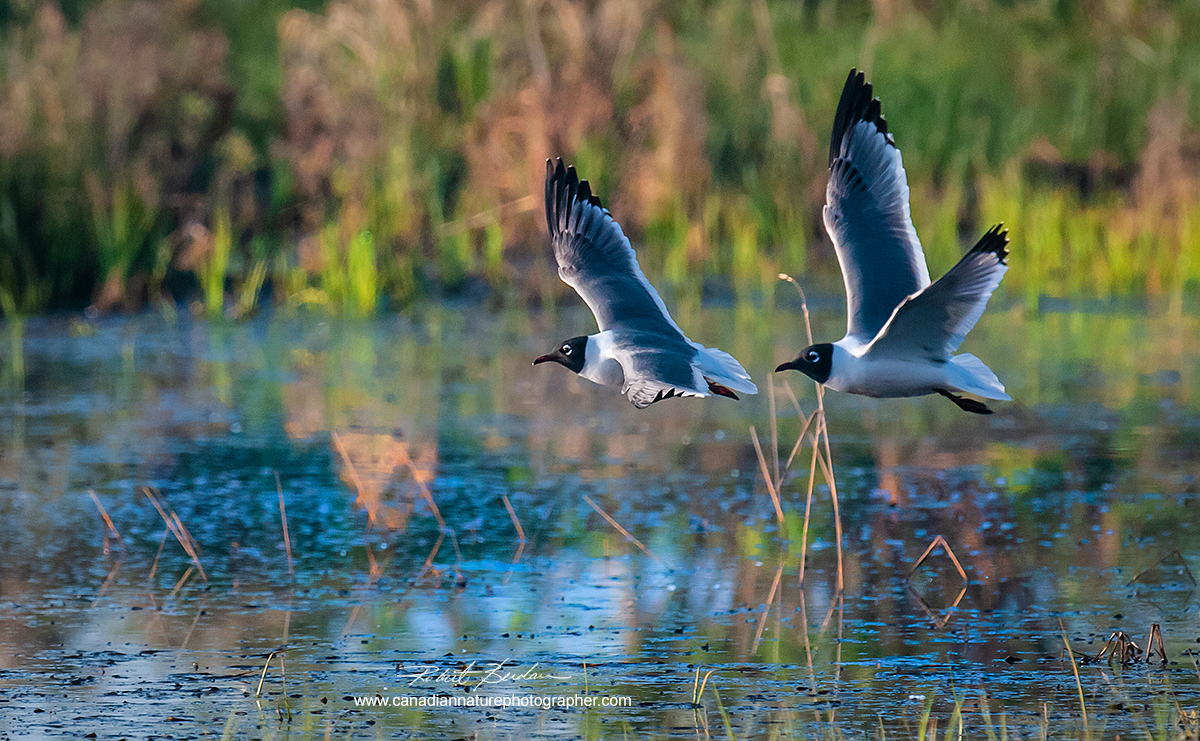
Franklin's Gull. These birds nest in a mass of floating bulrushes or other plants, they feed mainly on earthworms, insects and some seeds. Photographed east of Calgary.
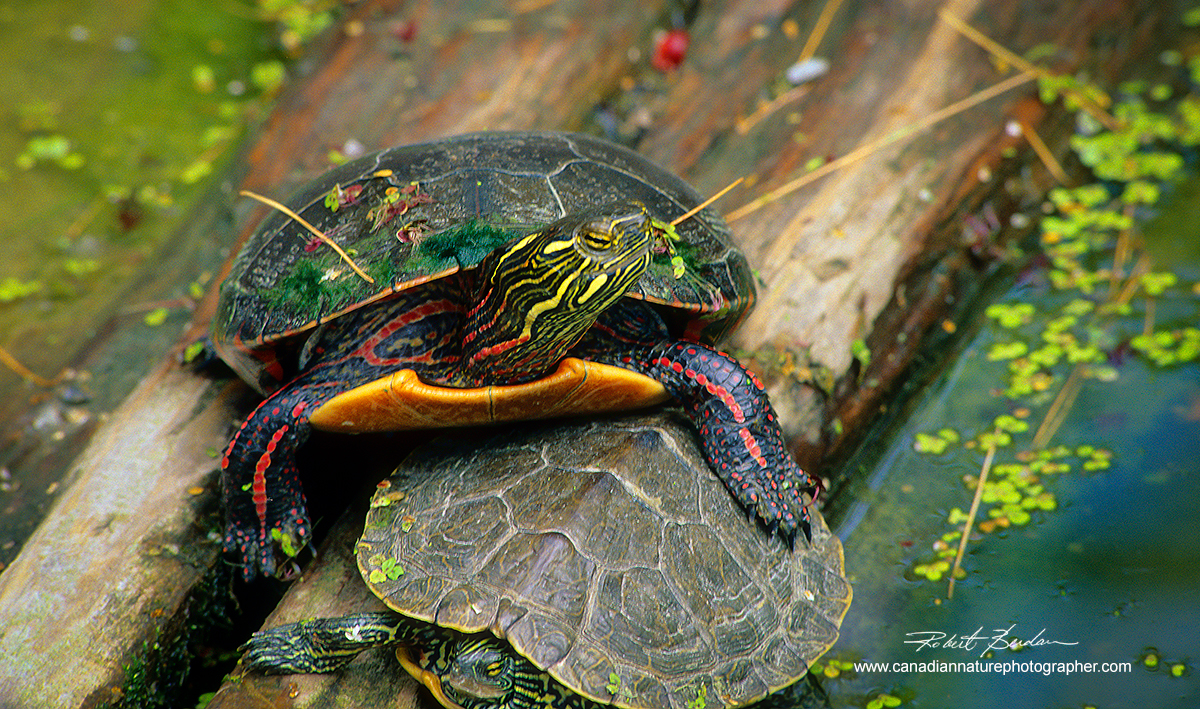
Painted turtles - Wye Marsh, Midland, Ontario. Painted turtles are the most widespread native turtles in North America and live in slow-moving fresh waters.
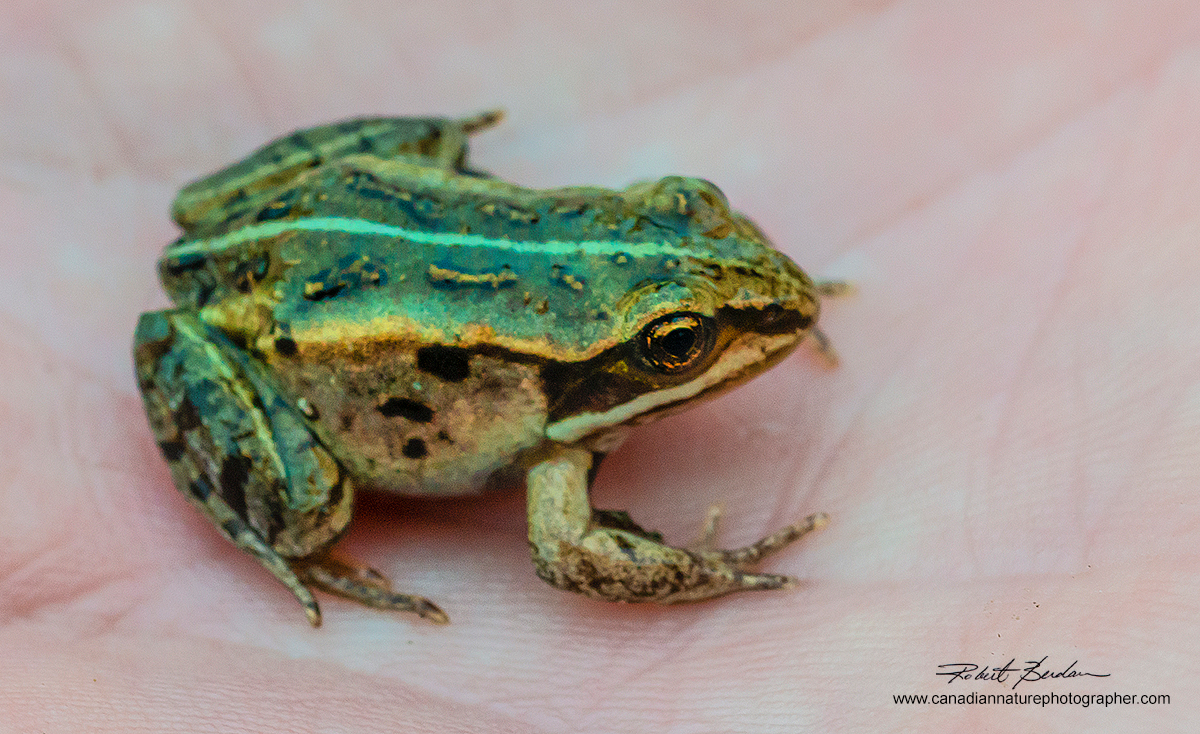
Wood frog in my hand - found in a pond near Bragg creek Alberta. The wood frog has received attention by biologists because of its freeze tolerance. Urea is accumulated in tissues in preparation for overwintering, and liver glycogen is converted in large quantities to glucose in response to internal ice formation. Both urea and glucose act as cryoprotectants to limit the amount of ice that forms and to reduce osmotic shrinkage of cells. Frogs can survive many freeze/thaw events during winter if no more than about 65% of the total body water freezes (Wikipedia).
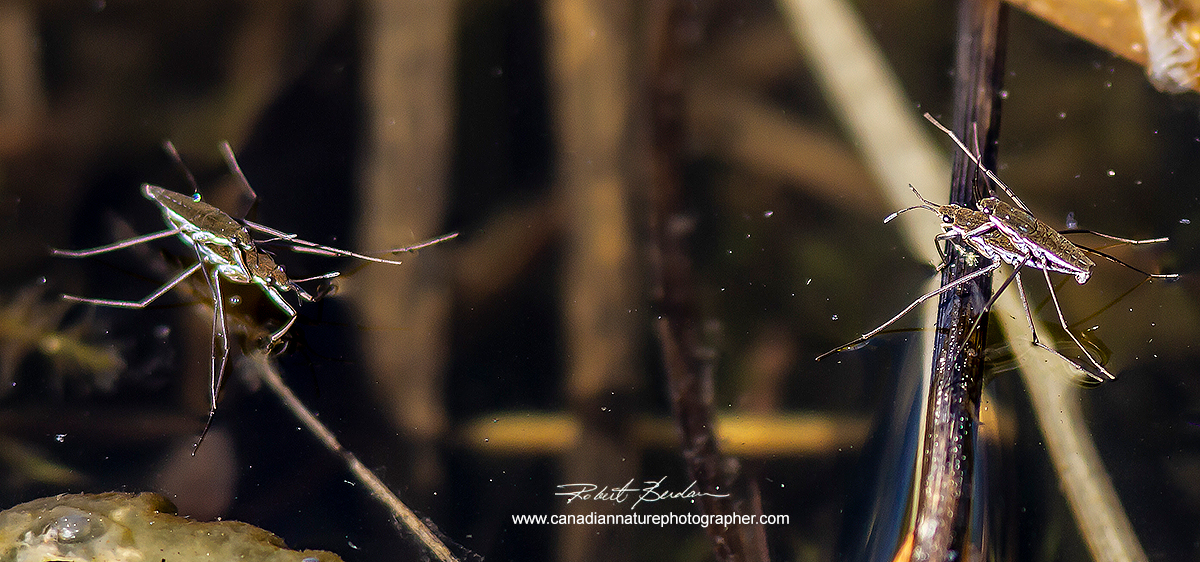
Water striders mating - these insects live on the top surface film of ponds. Water strider legs are covered in thousands of microscopic hairs scored with tiny groves. “These groves trap air, increasing water resistance of the water’s striders legs and overall buoyancy of the insect.”
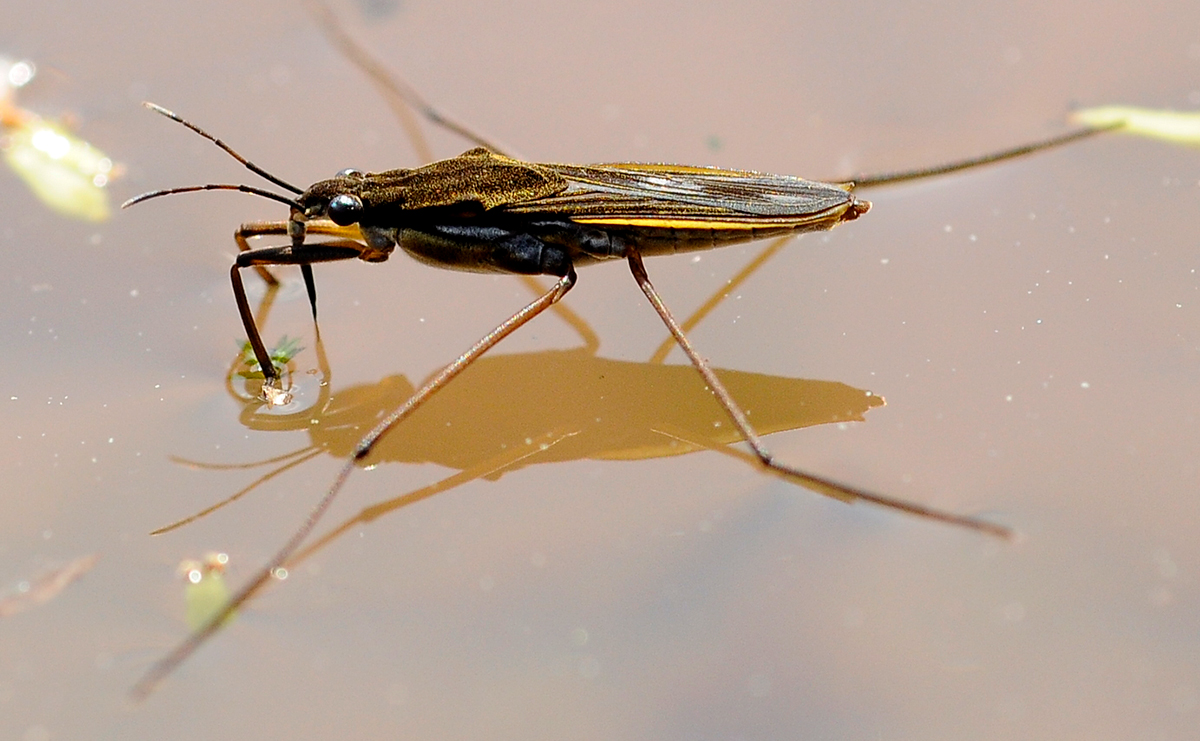
Gerris commun (Water strider) photo by Webrunner - Wikipedia commons about 10X
In addition to trees, there are wide variety of plants living along the edge of the marsh. Cattails and bulrushes are often the most conspicuous. There may be also be water lilies, and many smaller plants and flowers like water cress, alligator weed, glassworts etc. Growing in the water there are various types of algae including Water Milfoil, Hornwort, and Elodea. Along the edges of lakes and ponds you can sometimes find carnivorous plants like Sundew, and Northern Picture plants. You will also find a wide variety of insects, mosquitoes, dragon flies, damsel flies and their larvae living in the water. Water striders can often been seen skimming the surface - there are over 1700 species.
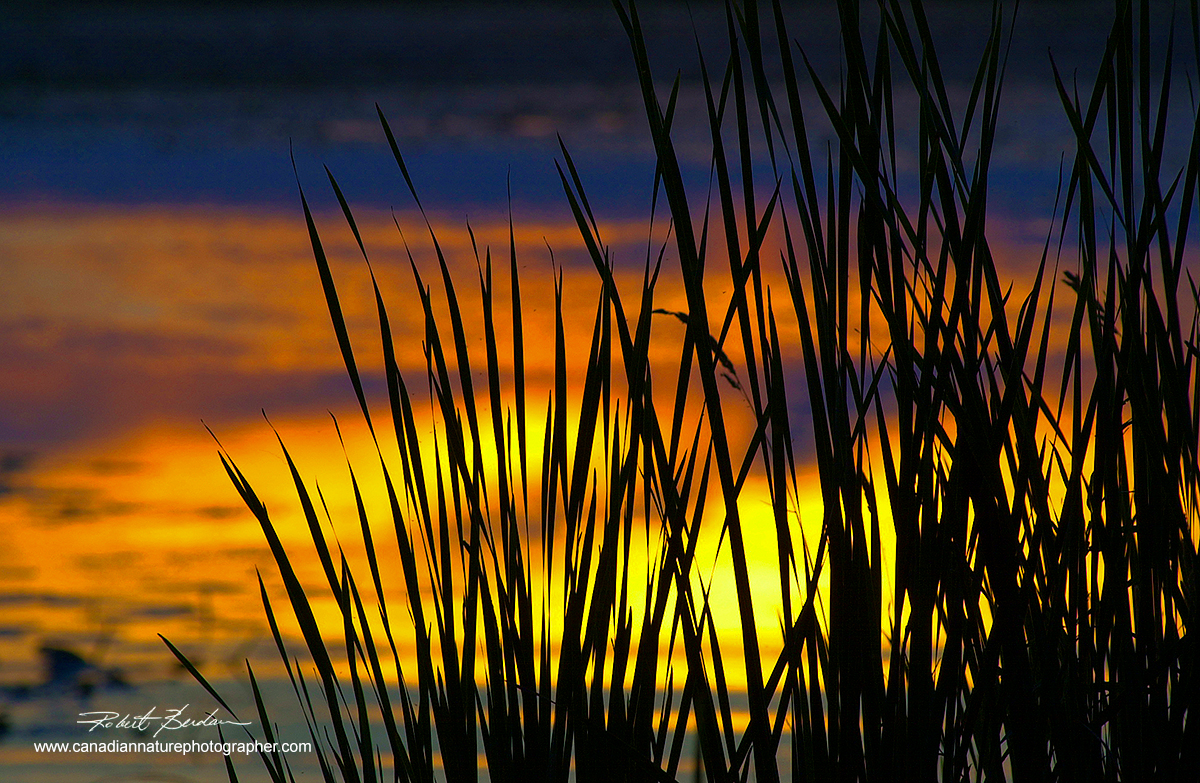
Cattails at sunset - Tiny Marsh Ontario.
The genus of Cattails is largely distributed in the Northern Hemisphere, where it is found in a variety of wetland habitats. The rhizomes are edible. Evidence of preserved starch grains on grinding stones suggests they were already eaten in Europe 30,000 years ago.
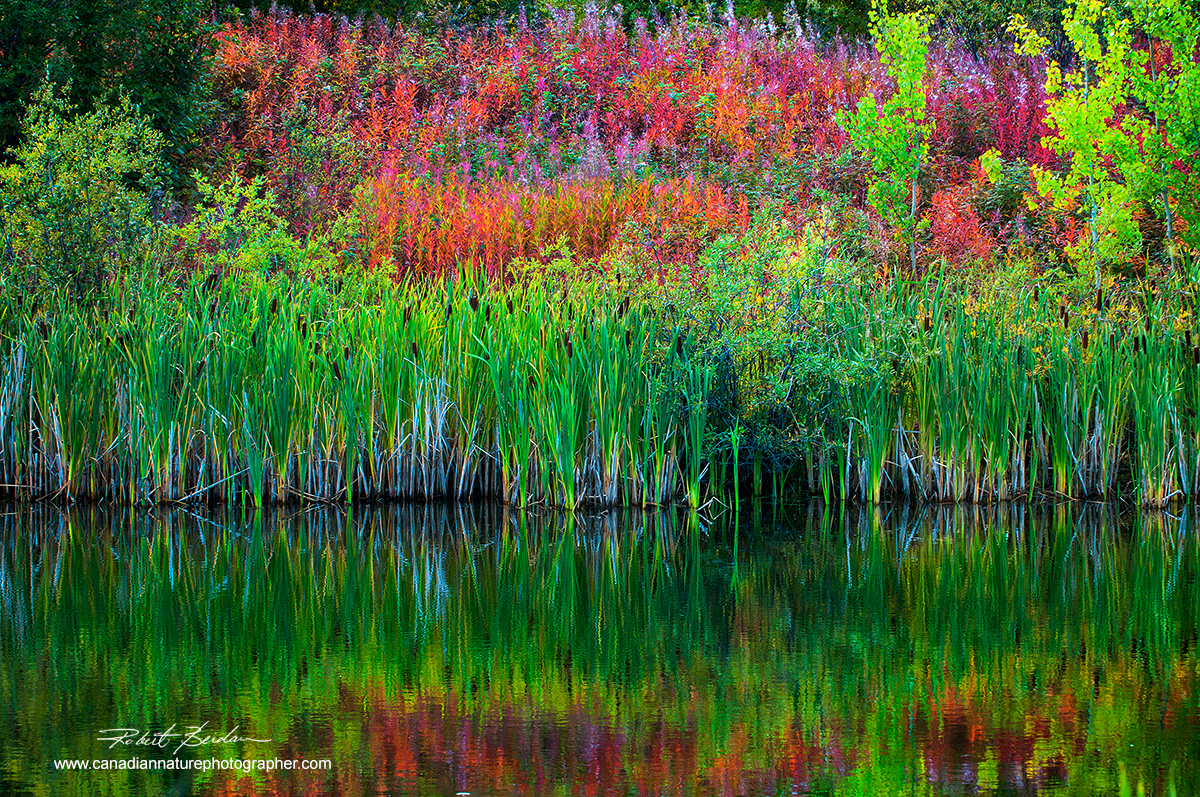
Cattails and Fireweed reflected in a pond outside of Yellowknife, Northwest Territories.
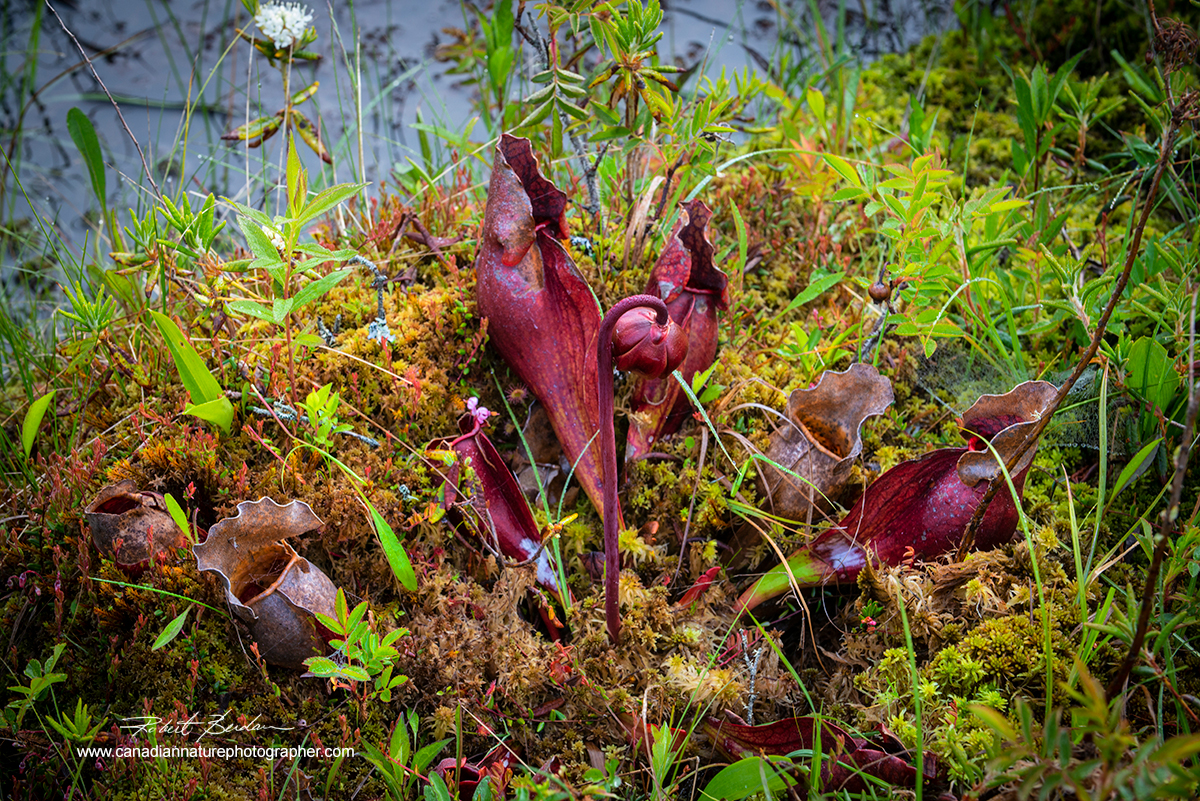
Northern Picture plants and moss in a marsh north of Halifax, Nova Scotia.
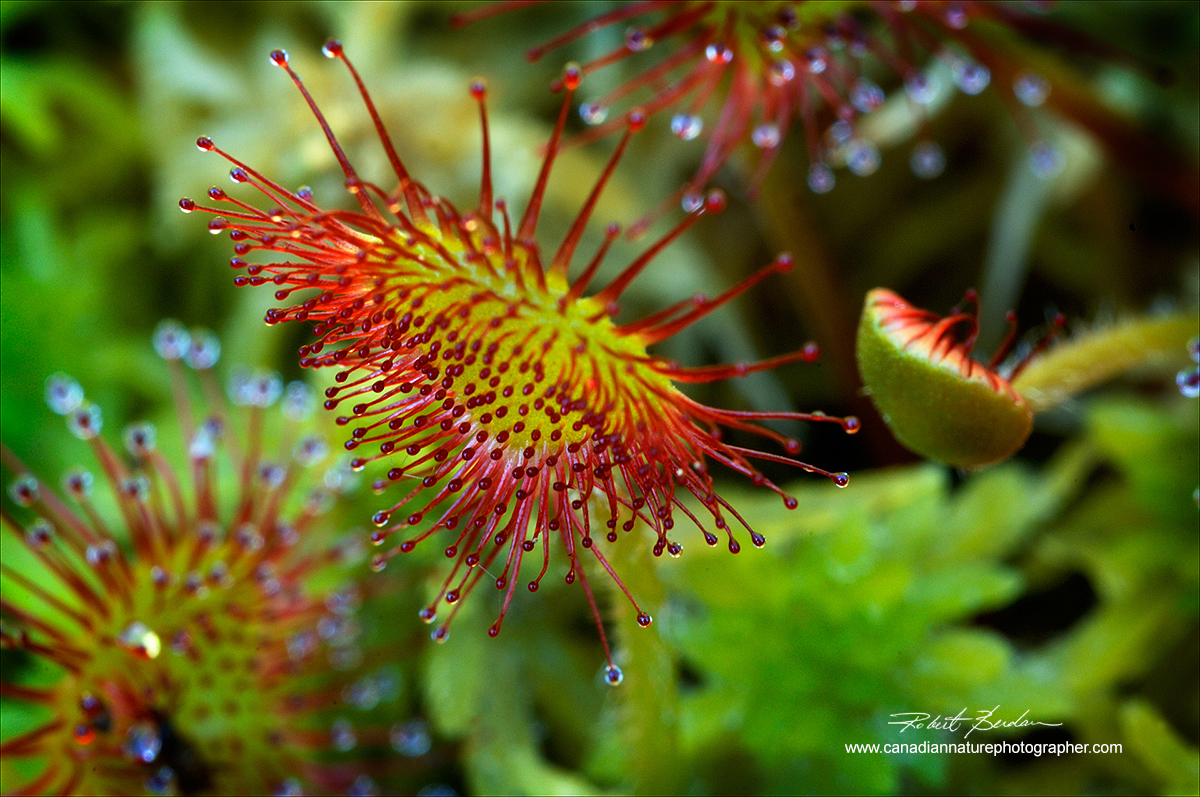
Sundew found in a marsh south of Revelstoke, British Columbia. These plants offer sticky tentacles to insects, and then trap them. Up close these plants are very colourful.
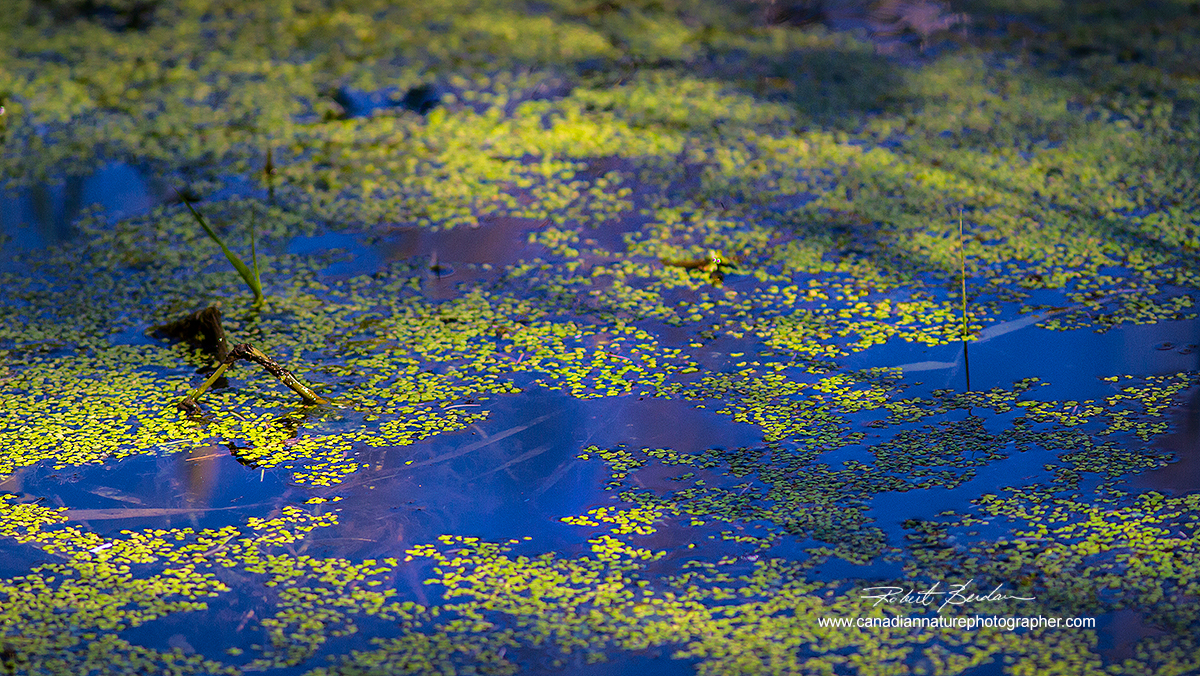
Duckweed are small aquatic plants that float on top of the water. Many microscopic organisms attach themselves to the bottom of the floating leaves.
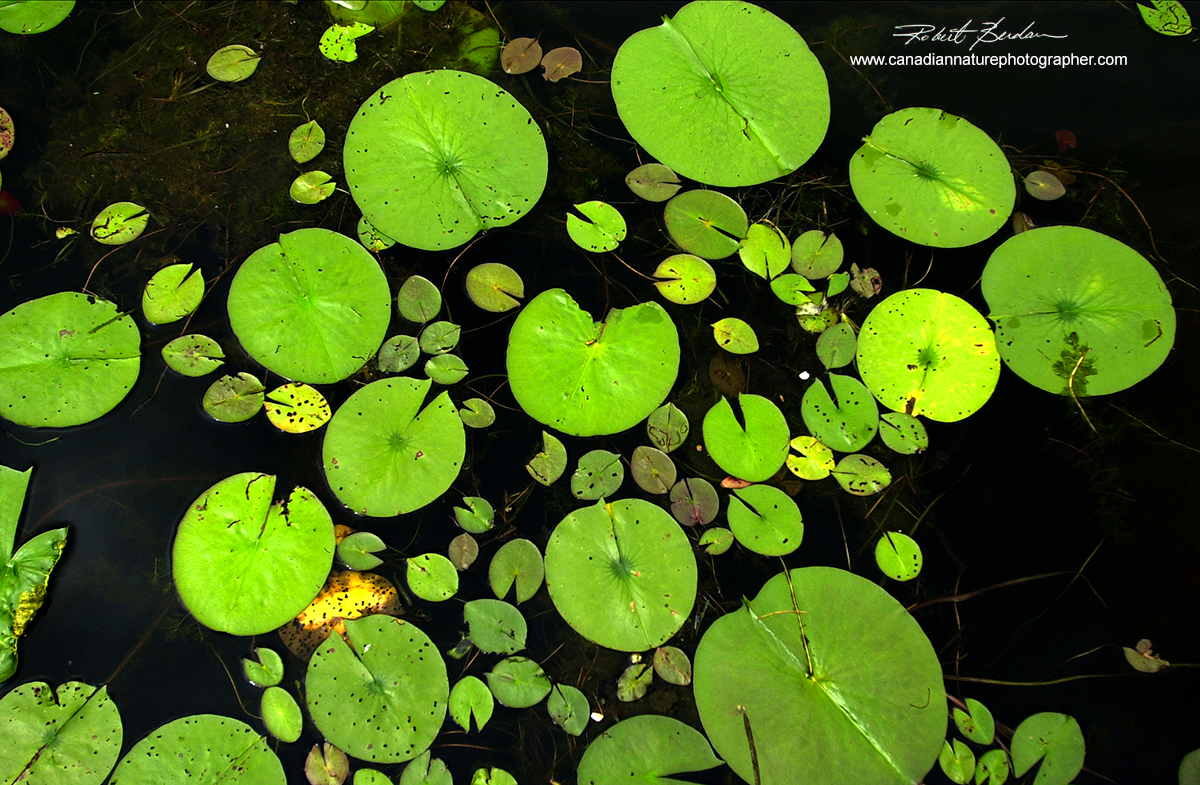
Lilly pads Wye Marsh, Midland, Ontario.
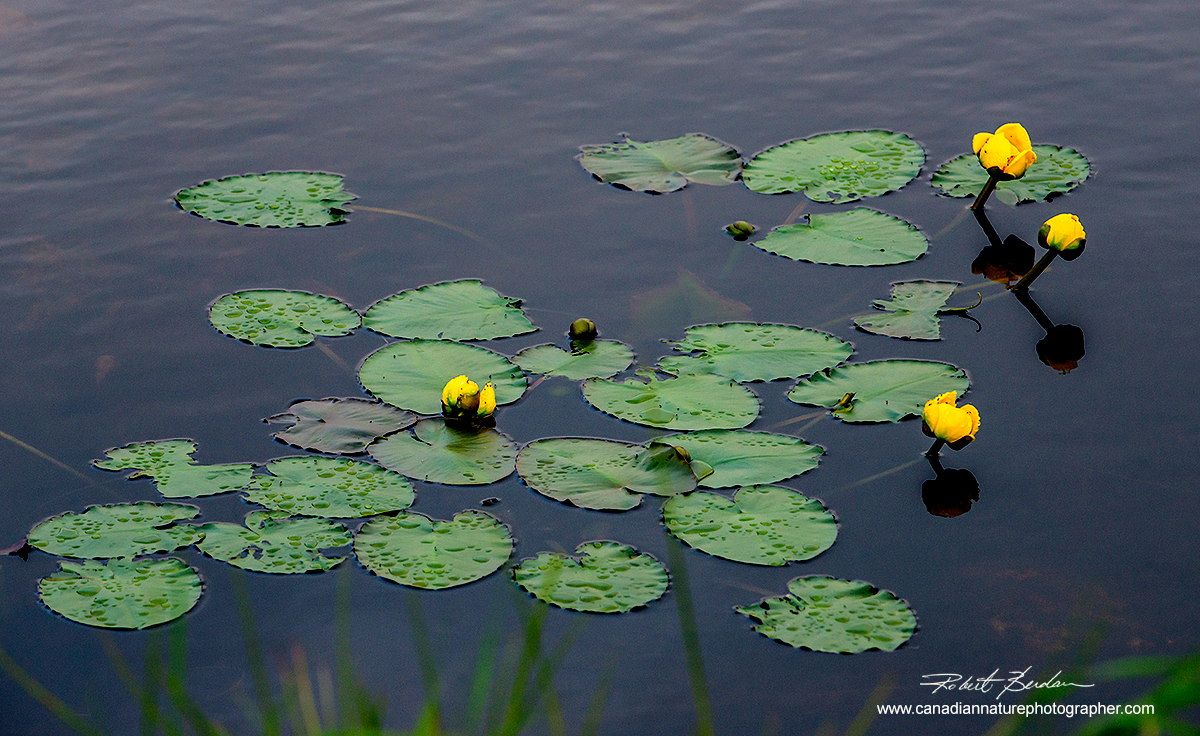
Yellow Water-lily photographed in New Brunswick.
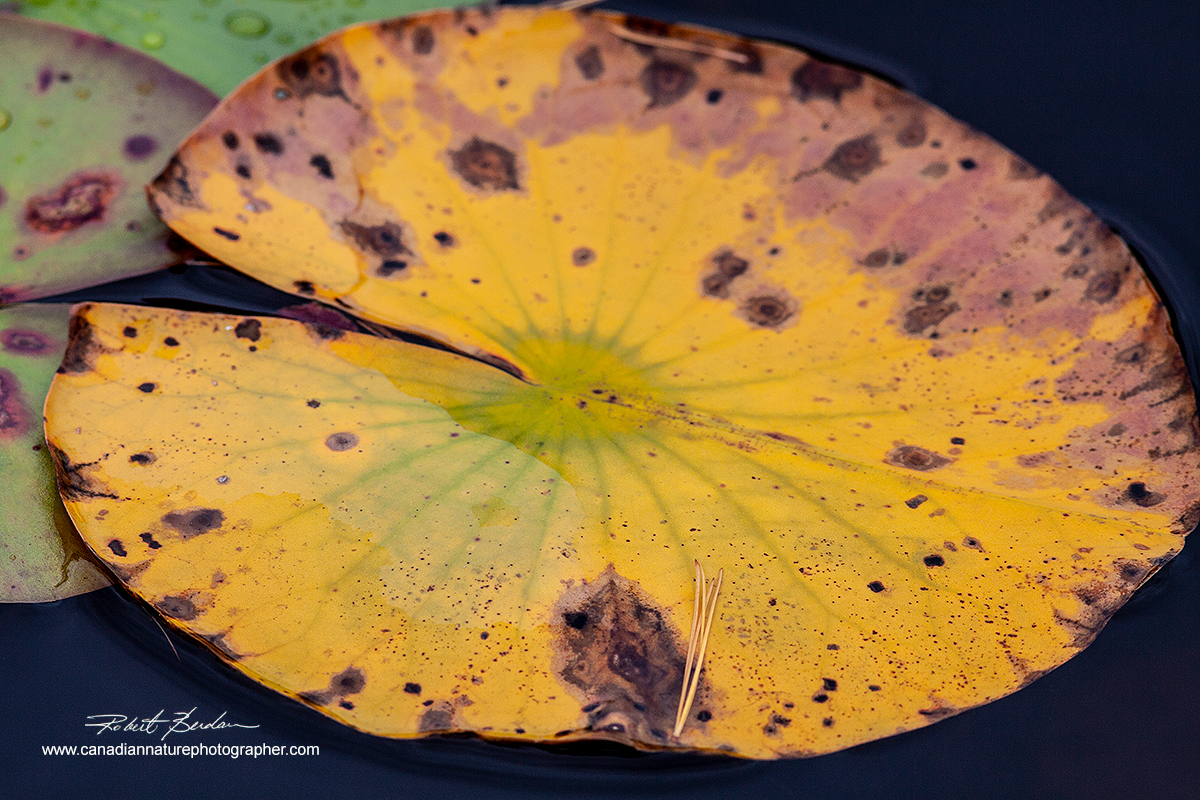
Water Lilly leaf.
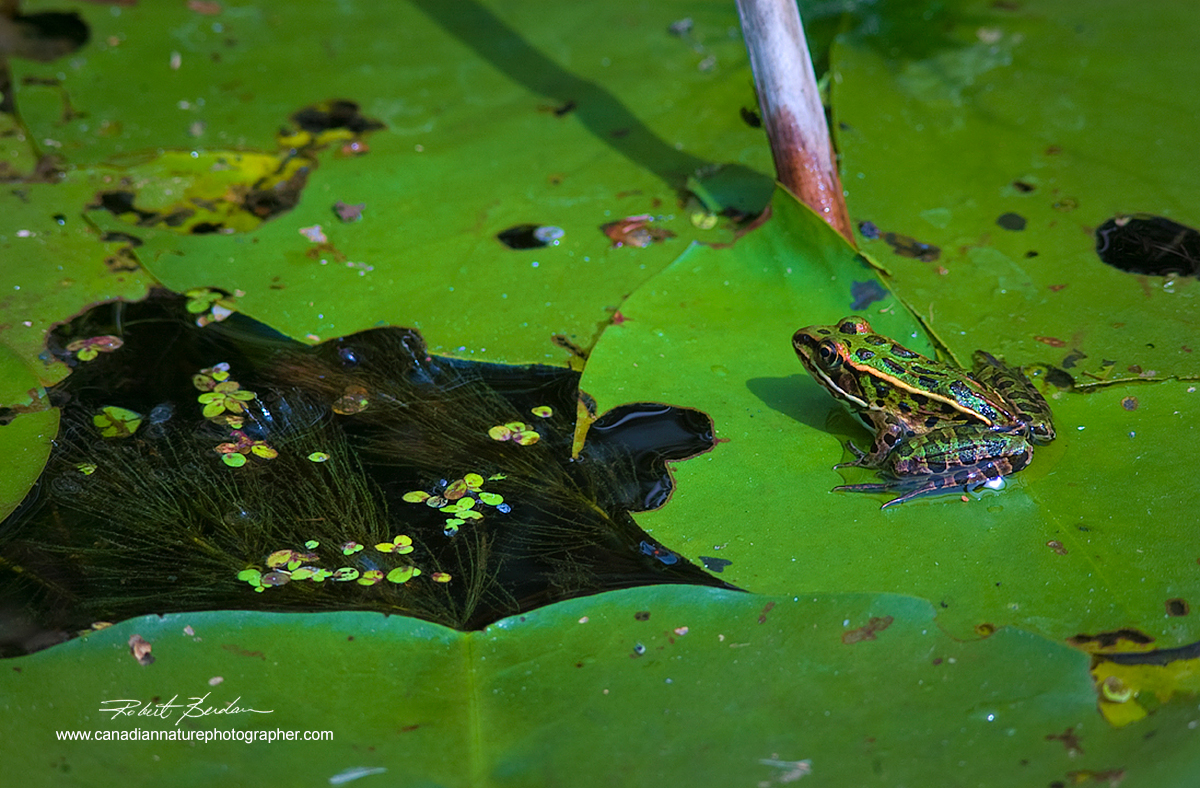
Leopard frog resting on Lilly pad, Wye Marsh, Midland, Ontario. These frogs eat insects, worms and smaller frogs including their own species.

Autumn leaves in pond, Georgian Bay, Ontario.
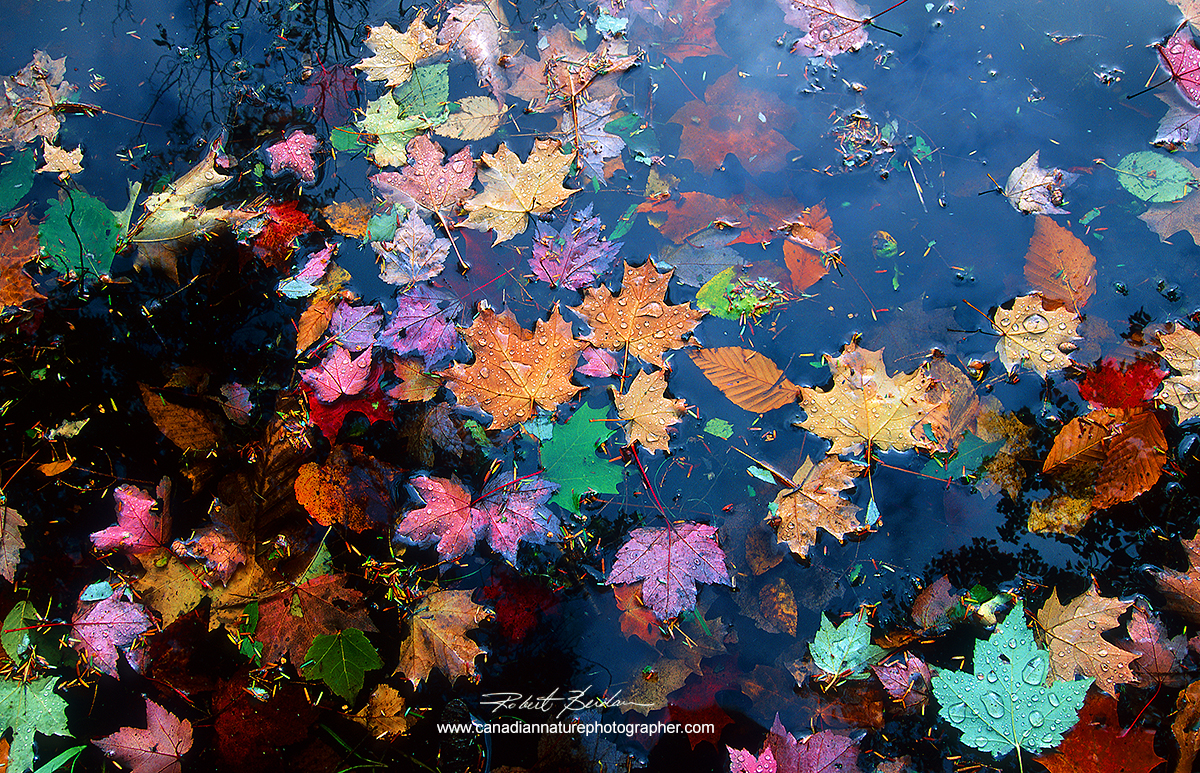
Maple leaves in pond, Georgian Bay, Ontario.
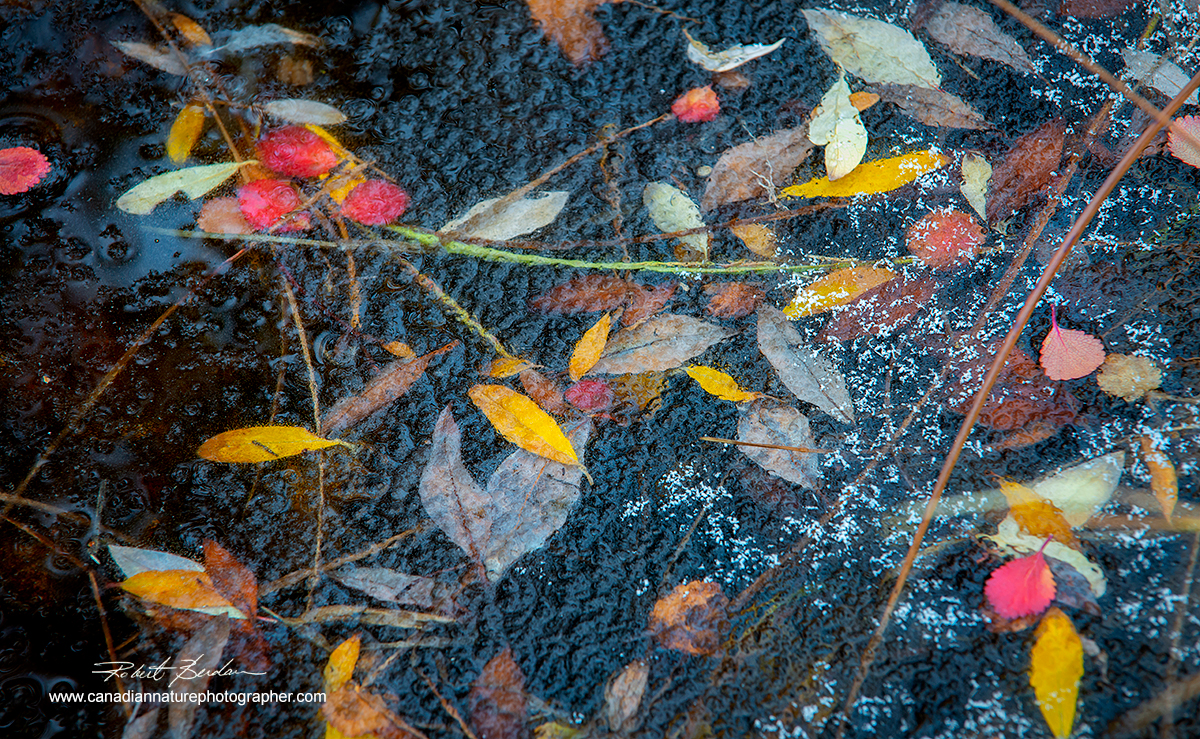
Autumn leaves trapped in ice on small pond.
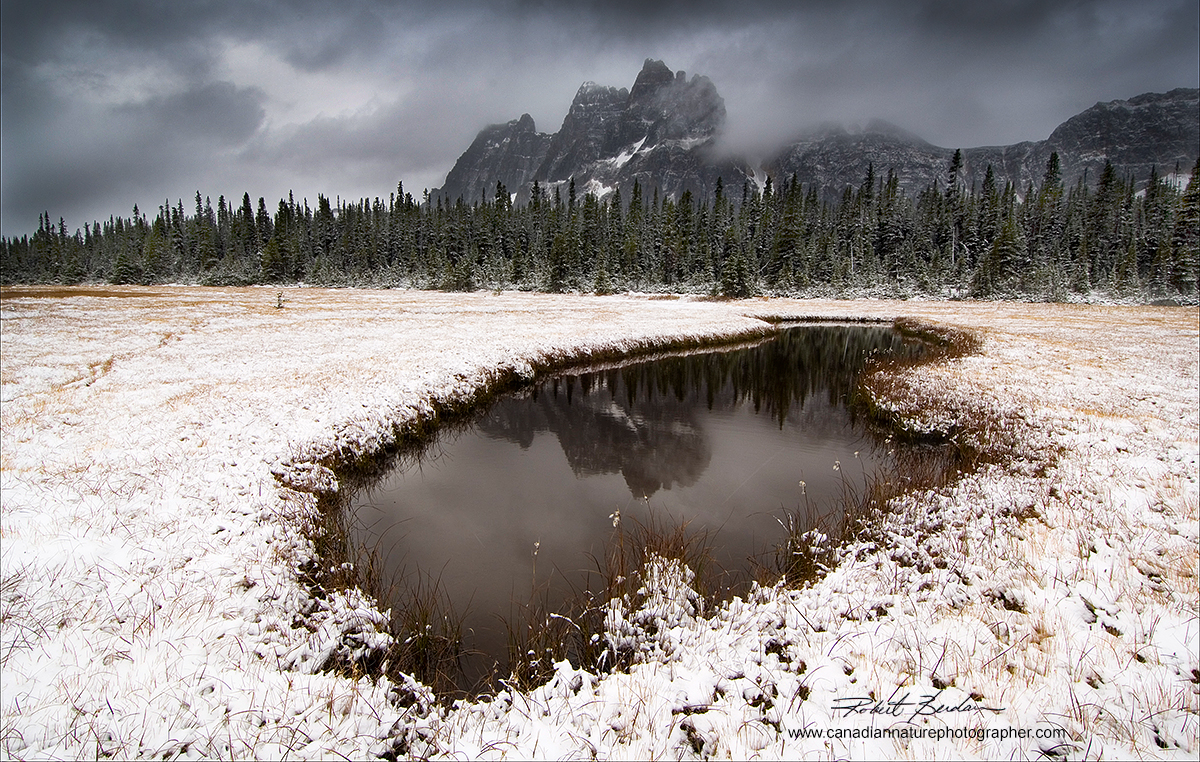
Pond after fresh snow, Tonquin Valley, Jasper National Park, Alberta.
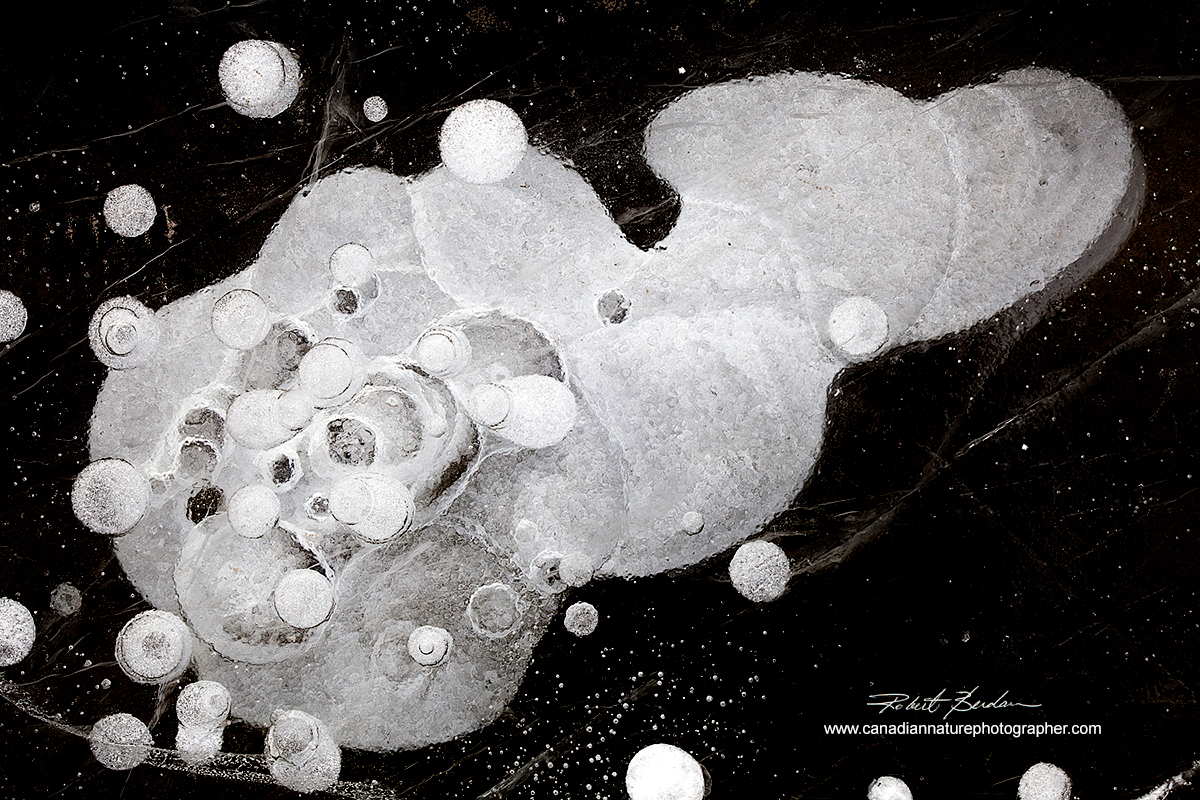
Air bubbles trapped in ice in a shallow pond, Alberta.
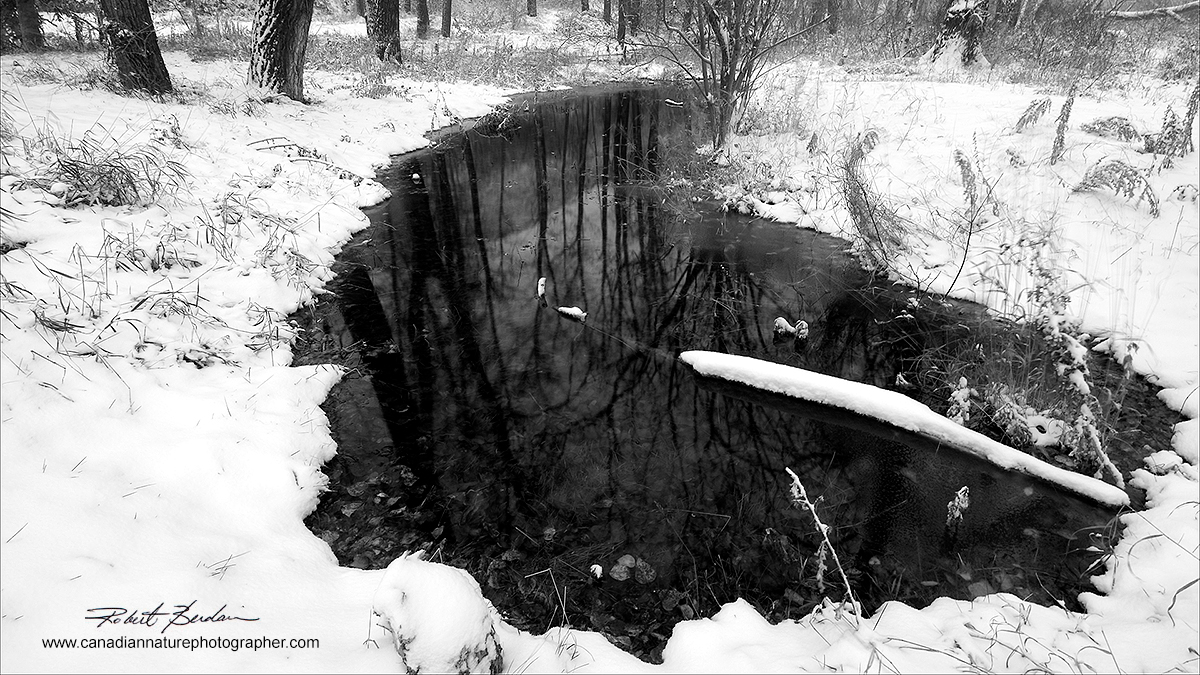
Pond in Bowmont Park in winter near my my home in Calgary.
Finding ponds are easy, there are lots of them along the bow river and city workers are creating more ponds to catch the water overflow from streets and allow some of the materials to settle out before entering the bow river. Many of these overflow ponds are teaming with life. For examples see some of my pictures of microscopic life living in ponds in Bowmont Park adjacent to Silversprings in Calgary. Small bodies of water can offer a wide variety of photographic opportunities all year long and they offer an opportunity to observe a wide variety of wildlife.
Photography tips
1. A telephoto lens and pair of binoculars is ideal for spotting and photographing birds around ponds and lakes.
2. A macro lens is good for photographing insects like dragon flies - photograph early in the morning when the insects haven't warmed up enough to fly away and you may even find some dew on them.
3. Wear rubber boots so you can wade into the shallow areas of the pond - avoid deep areas as the mud can fill your boots and trap you (I have been caught in the mud a few times).
4. Visit the pond at different times of the day and during different seasons, before walking onto the ice be sure it is at least 4 inches (~7 cm) thick (Ice - Thickness & Safe Load) -read additional notes on ice thickness here - always exercise caution on ice as the thickness may vary in thickness in places, especially ice over moving water. Stay near the edges of the pond for your own safety.
5. Consider an underwater camera for taking pictures below the surface of the pond.
6. Download the Kananaskis country aquatic animal identification guide - free PDF
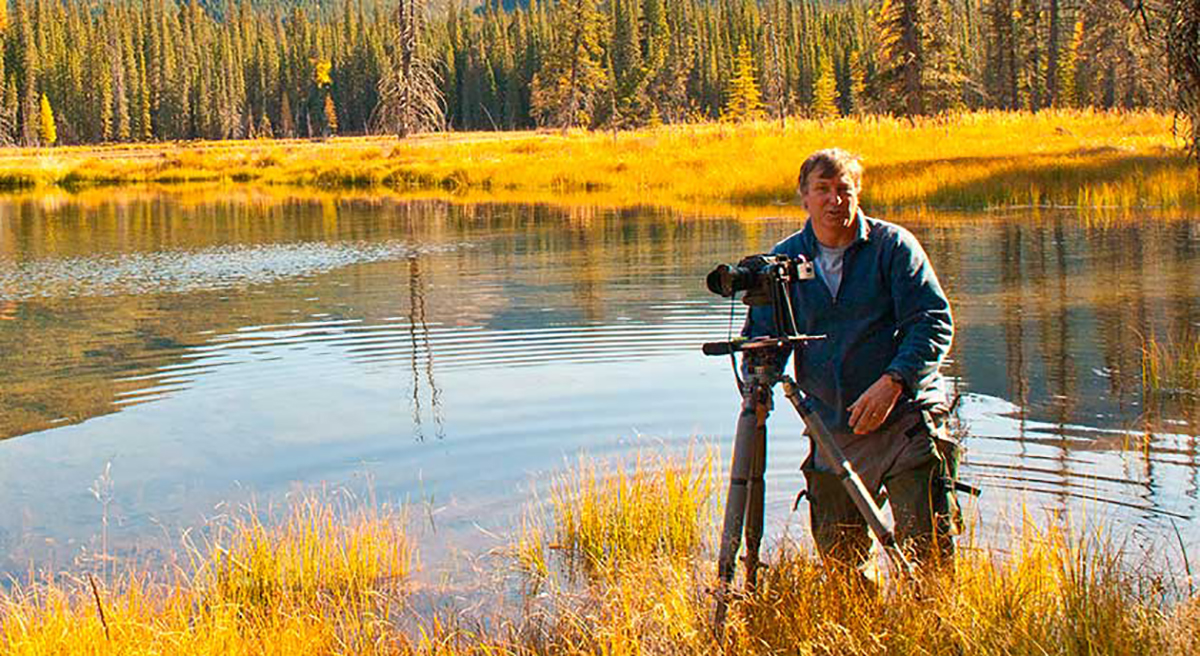
I am in this pond wearing hip waders. I was hired to photograph panoramic images of ponds and rivers for the Bow Habitat centre in Calgary. Photo by Hälle Flygare.
In Alberta many birds migrate and use ponds and marshes as staging areas to refuel before continuing on their migrations e.g. Tundra Swans and Trumpter Swans. Staging areas are places where migrant birds stop to rest, drink, and eat (read about the difference between stopping and staging). In this short article I only scratched the surface when it comes to looking at insects living in ponds, and ponds can be a source of pesky mosquitoes. Overall though there is beauty that can be found in ponds and we can learn a lot of about animal life cycles, fish, ecosystems, eco-diversity, food-chains, reproduction and early development in organisms which is why many schools and biology classes study pond-life. We are also learning that Wetlands are important in water and air purification. More importantly wetlands can provide a rich natural environment that can fill us with awe an uplift the human spirit. RB
Note: students and teachers you may use my photos freely.
Links to Additional References
Microscopic Pond Organisms from Silver Springs Calgary - There is beauty in Pond Scum
Pond Life Viewed with a Microscope I
Pond Life Viewed with a Microscope II
Frank Lake - Birding Hotspot Near Calgary
Photographing Shore Birds, Waterfowl and Other Wetland Birds
Bow Habitat Station and Fish Hatchery - many of the photos on display are mine and there are ponds on site you can collect from.
It came for a Pond - Bruce Taylor
Pond Life - pond and fish-keeping
Pond Life - 42eXplore for kids numerous additional links
Pond Life - resource for teaching AAAS
Pond Cultures of Microscopic Invertebrates - Rice University
Wye Marsh - in Midland Ontario
Marshes and Wetlands in Alberta - Ducks Unlimited Canada - PDF
Alberta Wetland Classification System - Alberta Government
Earth's Kids - Ponds & Wetlands Science.
Open Spaces as Learning Places Pond Unit - learning outline - PDF
Knowledge Project - Ponds and Lakes: A Journey Through the Life Aquatic - see references
Pond Life Discovery Pack - Kananaskis country Free PDF
Pond Life a Pocket Guide - Amazon
Pond Life - a Golden Guide - this small illustrated book is great for kids - Amazon
Ponds and small Lakes - good book with keys, I found a cheaper copy online as a PDFEnvironmental Microbiology of Aquatic and Waste Systems - book for scientists - PDF
Authors Biography & Contact Information
 Bio: Robert Berdan is a professional nature photographer living in Calgary, AB specializing in nature, wildlife and science photography. Robert retired from Cell\Neurobiology research to take up photography full time years ago. Robert offers photo guiding and private instruction in all aspects of nature photography and Adobe Photoshop training - including photomicrography, macrophotography.
Bio: Robert Berdan is a professional nature photographer living in Calgary, AB specializing in nature, wildlife and science photography. Robert retired from Cell\Neurobiology research to take up photography full time years ago. Robert offers photo guiding and private instruction in all aspects of nature photography and Adobe Photoshop training - including photomicrography, macrophotography.
Email at: rberdan@scienceandart.org
Web site: www.canadiannaturephotographer.com
Phone: MST 9am -7 pm (403) 247-2457.
Click on the buttons below and share this site with your friends